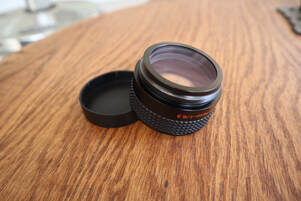 Celestron's 6.3X focal reducer/field flattener is a very popular accessory for non-Edge SCTs because it reduces the focal ratio of the SCT from its native f/10 to f/6.3. This increases the field of view (FOV) and increases the optical speed of the SCT as well. Both effects are helpful for astrophotography and Electronically Assisted Astronomy as they make shorter exposures possible and allow larger Deep Sky Objects (DSOs) to fit in the camera's sensor. And because it is also a field flattener it will improve the sharpness of the image at the edge of the FOV. The same benefits of a wider field and more intense image apply to visual observers as well Reducing the focal ratio with this reducer speeds up the optics by a factor of (10/6.3)^2 = 2.5. It concomitantly increases the FOV by the same amount. For instance, an 8" SCT with the ZWO ASI533MC camera has a FOV of 19.4 x 19.4 arcminutes at f/10 which increases to 30.8 x 30.8 arcminutes at f/6.3. That is 376 arcminutes-squared vs 949 arcminutes-squared with the later 2.5X the former. For the 8" SCT the focal length reduces from 2000mm to 1260mm with the reducer. Determining the Correct Back Spacing Target For any focal reducer to work as designed It is important to place the sensor of the camera at the correct back spacing, or distance, from the focal reducer. This will ensure that the focal reduction will match the design target, in this case 6.3X. It also ensures that the field flattener works optimally to provide sharp, round stars to the edge of the FOV. If the camera's sensor is placed closer to the focal ratio will be larger, say 6.5X or 7X, and the focal reduction will be less. If it is placed further from the reducer the focal ratio will be smaller, say 6X or 5X, and the reduction will be more. In addition, the field flattener will not perform optimally so stars near the edge of the FOV may be distorted. For astrophotography we want to get the best possible images so we want to be as close to the ideal back spacing as possible. For Electronically Assisted Astronomy (EAA) we may be less fussy about the edge of the FOV and more interested in speeding up the optical system and/or fitting more of the larger DSOs in the FOV. In that case a slightly larger back spacing is sometimes used. Regardless, it is important to know how to get the correct back spacing to begin with. 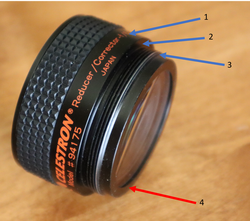 Different locations often identified as the back spacing measurement starting point. 1) Center of the internal lens'; 2) Inner flange; 3) Outer edge of the threads; 4) Back flange. Different locations often identified as the back spacing measurement starting point. 1) Center of the internal lens'; 2) Inner flange; 3) Outer edge of the threads; 4) Back flange. So, how do we achieve the correct back spacing when using the Celestron 6.3X focal reducer? We need to know the correct back spacing and how it is measured. If you search the internet you will find answers ranging from approximately 100mm to 110mm with the most common answer being 105mm. Surprisingly Celestron has not published a spec for the back spacing for this reducer. If you also look to find out where on the focal reducer the back spacing measurement is made, this is where you will find the most disagreement. Some suggest the measurement should be made from the center of the lens' inside the focal reducer (1 in the image above), others from the flat surface on the inside of the threads (2), or the back edge of the threads (3) as shown in the photo. The correct answer to both of these questions is 105mm from the extreme back surface of the focal reducer as shown in the photo identified as location 4 in red. So how do we know that these are correct? 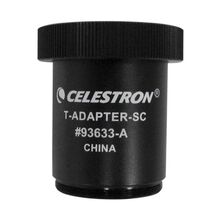 Celestron SCT T-Adapter (50mm) Celestron SCT T-Adapter (50mm) First, we know that the industry standard back spacing for focal reducers used on refractors is 55mm (there are some exceptions). Second, because the optics of an SCT is very different from a refractor it is not possible to make a focal reducer for an SCT with a back spacing of 55mm. So, Celestron did the next best thing. They made an adapter which attaches to the back of the focal reducer and is exactly 50mm long. This leaves the industry standard 55mm left to obtain the correct back spacing of 105mm. Also note that the 50mm length of this adapter is measured from the the flat surface of the flange which mates with the surface "4" in the image above to the flat surface on the other end of the adapter not including the threads where the next spacer will bottom out when screwed all the way on. Similarly, Celestron makes a 7X focal reducer for their Edge SCTs and in this case they do specify the back spacing as 146.05mm. And likewise, they make a T-Adapter to attach directly to this focal reducer which is 91mm long leaving 55.05mm of additional spacing to meet the back spacing spec. So, I think it is clear that the design back spacing for the 6.3X reducer is 105mm and not 100mm, 110mm or something else, and that it is measured from surface 4 on the focal reducer. Imaging Train Options for the 105mm Back Spacing Now that we have established that we need 105mm of spacing for the Celestron 6.3X reducer we need to figure out what options are readily available. But first, we need to take into account the back spacing of the camera sensor itself. This can be found from the manufacturer and we will use ZWO's ASI cameras as an example. Below is ZWO's mechanical drawing for their ASI2600MC camera. This shows the position of the CMOS image sensor relative to the front surface of the camera to be 17.5mm. Likewise the ASI585MC has a back spacing of 17.5mm for the sensor even though it uses a different coupler on the front face. If you look at most cameras these days from ZWO and other manufacturers you will find that 17.5mm is the most common back spacing for the sensor. However, be careful to check as the ASI224MC shown below only has a 12.5mm back spacing. Like plumbing or garden irrigation systems there are many different spacers and adapters available such that one can find many combinations of such to make up the additional back spacing needed. After searching through multiple astronomy supplier's sites I have come up with what I believe to the be the least complicated solutions using the simplest set of adapters available to achieve the 105mm back spacing. I list the parts needed below along with links to either Agena Astro or HighPoint Scientific, two of my goto astronomy suppliers. Links are affiliate links which will earn a small commission at no cost to you. Please use these if you can to support my web site. From Agena Astro Celestron 6.3X focal reducer Celestron 50mm SCT-T Adapter Blue Fireball 37.5mm Extension ZWO 11mm Female to Female Adapter If you want to fine tune the spacing you can use Baader T2 Delrin spacers to adjust the spacing in small increments from 0.6 to 1.4mm. If you want to make larger spacing changes you can search for the desired M42/T2 spacer from Blue Fireball, or substitute the Baader Varilock 46 T2 Variable Extension in place the 37.5mm Extension listed above for greater versatility. Here is an almost identical solution from HighPoint Scientific. Since they do not list a 37.5mm spacer it uses a 30mm and 7.5mm spacer which are sold together as a kit from Celestron. From HighPoint Scientific Celestron 6.3X focal reducer Celestron 50mm SCT-T Adapter Celestron M42 Spacer Kit (30mm + 7.5mm) ZWO M42 Female to Female 11mm Adapter Alternatively to the Celestron M42 spacer kit one could substitute the Baader Varilock 46 T2 Variable Extension which, while almost twice as expensive, allows for variability in the spacing. Also the Baader T2 Delrin Spacer Ring Set is an option for fine tuning the spacing on the order of a mm or less. Back Spacing Solutions With a Filter Drawer Now if we want to use filters with our camera we can put a filter drawer in line so that it is easy to change filters in real time. In this case we will need some different spacers and adapters. Also, we need to take into account the fact that the glass of the filter has a different index of refraction compared to air. Filter glass is typically 2-3mm thick so we need to add ~1/3 of that thickness to our optical path for an additional ~1mm. Below is the same setup as above showing the parts needed along with links to either Agena Astro or HighPoint Scientific. Agena Astro Celestron 6.3X focal reducer Celestron SCT-T Adapter Blue Fireball 10mm Extension Blue Fireball 7.5mm Spacer Ring ZWO M42 11mm Female to Female Adapter ZWO Filter Drawer M42 Male to M48 Female ZWO M48 Male to M42 Female Adapter HighPoint Scientific Celestron 6.3X focal reducer Celestron SCT-T Adapter Apertura10mm Extension Baader 7.5mm T-2 Extension ZWO M42 11mm Female to Female Adapter ZWO Filter Drawer M42 Male to M48 Female ZWO M48 Male to M42 Female Adapter Back Spacing Solutions for SE/Evo/CPC Mounts at 90deg Altitude The solutions above work with cooled and uncooled cameras on any Equatorial mount. In the case of a single arm Alt-Az mount like the Celestron SE or Evolution mounts, or a dual arm mount like the CPC mount, the solutions above will only work as long as the OTA is not pointed higher than ~75 degrees in altitude. Higher altitudes will cause the camera to crash into the base of the mount. A simple solution to reach an altitude of 90degrees without hitting the mount is to add a rail extension along with the imaging trains shown above so that the OTA can be pushed forward to provide enough additional clearance. An inexpensive rail extension is available from SVBony which will work on the 6" SCT. The longer Celestron Universal Mounting Plate is probably a better option for the 8" and 9.25" SCTs and is available from both Agena Astro and HighPoint Scientific. If using a cooled camera there will not be enough room to push the OTA forward and a different approach is needed. This approach uses a diagonal to place the camera at a right angle to the optical axis to gain additional clearance. The details of this configuration can be found in the equipment recommendations section of this web site here. If you would like to see all of these configurations in action, please take a look at the video I put together on this subject where I demonstrate each solution in detail. The video is on my YouTube channel here where you can also find other helpful videos for the amateur astronomer. All links are affiliate links which can earn a commission without any additional cost to you. Please consider using them to help support this channel.
0 Comments
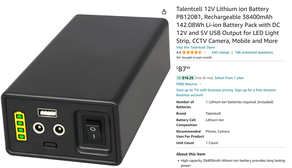 Talentcell sells a line of small and light weight portable power banks which have become very popular among amateur astronomers over the years. Their easy portability means that they can be carried out to a dark sky location or taken to public outreach events to provide limited power without the added burden of a larger capacity battery. It also means that the power bank can be attached to the telescope mount or optical tube to minimize cabling. Advertised on Amazon as 12V batteries Talentcell's power banks are available at prices ranging from $26 for their 3Ah model to $88 for their 12Ah model which can really help to keep the cost of portable power low. One should expect that even the smallest capacity power bank should be enough to power a modest sized mount like a Celestron SE Alt-Az or AVX EQ mount, or a Sky-Watcher Star Adventurer along with a few accessories for several hours. I have used their 8.3Ah model to power a Celestron 6SE along with an analog video camera and 10" LCD when doing EAA at public outreach events. I suspect that hundreds, if not thousands of amateur astronomers have been using these power banks for years completely unaware that they actually are not 12V batteries at all and do not even supply 12V once a load has been applied. I count myself as one so unaware for many years until I started seeing complaints on CloudyNights about problems using these Talentcells to power ASIAIR computers or ZWO AM3 and AM5 mounts all of which had a problem with the actual voltages supplied by the power banks. This prompted me to take a detailed look at the design of the Talentcell power banks. I eventually purchased 3 more Talentcells to run through extensive testing along with my original 8.3Ah model to demonstrate for myself that these are not really 12V batteries and do not provide an output voltage of 12V except when no load is applied. It is important in this discussion to distinguish between the many Talentcell power banks which are advertised as "Lithium ion" or "Li-ion" batteries versus the 2 Talentcell models which are advertised as "LiFePO4 Battery Packs". Of the former I count at least 9 different models being advertised on Amazon as of this writing versus 2 models of the later identified as "LiFePO4 Battery Packs". So what are the differences between these 2 different types? First, the 9 models advertised a "Lithium ion" use LiNiMnCoO2 as the internal power cells. LiNiMnCoO2 (NMC) is a very common Lithium Ion cell used in many applications, primarily where weight is a key concern such as in ebikes, electric power tools, some models of electric cars including many models of the Tesla, and in most of the portable power stations like the Jackery sold to date. NMC is considered one of the safest Lithium cells with a thermal runaway temperature second only to LiFePO4. Power supplies with NMC cells are usually rated for ~500 full discharge cycles after which 75 - 80% of the original capacity remains. In contrast power supplies with LiFePO4 are rated at 4,000 or more full discharge cycles which is why these are found in the batteries used in RVs and boats. LiFePO4 cells are now beginning to show up in portable power stations from Jackery and others. The other main difference between NMC and LiFePO4 cells, and one of the keys to understanding the problem with many of the Talentcell power banks, is their nominal cell voltages. NMC has a nominal cell voltage of 3.6 to 3.7V. That means when fully charged it has a useable energy capacity starting at 3.6 or 3.7V. On the other hand, LiFePO4 has a nominal cell voltage of 3.2V which actually makes it an ideal lithium cell type for creating a 12V battery as 4 of the LiFePO4 cells in series will provide 12.8V. On the other had, 4 NMC cells in series will provide 14.4 to 14.8V which is too high for a typical 12V system. This is why a Jackery portable power stations using NMC cells have an internal voltage regulator to keep the output voltage in the 12V to 13.2V range throughout 100% of its depth of discharge (DOD) at which point the internal BMS shuts down the output. In contrast, a 12V battery using LiFePO4 cells does not need a voltage regulator so its voltage remains above 12.0V throughout 95% of its DOD. The voltage versus capacity curves shown above for LiFePO4, LiNiMnCoO2 and a lead acid battery demonstrate this quite clearly.  Talentcell 12V/6000mAh technical specs Talentcell 12V/6000mAh technical specs So why do I say that the Talentcell power banks using NMC cells are not 12V batteries? To understand this we need to take a look at the design of these power banks. Here we have Talentcell's own advertised design information which shows that they are using 3, not 4, NMC cells in series and then adding multiples of these in parallel to increase the capacity as needed. Here is an image of their 6Ah design which has 6 total cells configured as 2 parallel banks of 3 cells in series. The 3 cells in series can only produce 3 x 3.7V = 11.1V , not 12.8V. Interestingly, if you look closely at Talentcell's own specifications you will see that they indicate 11.1V 6000mAh for the capacity in the technical details for this battery, not 12V 6000mAh. (6000mAh is 6Ah). Yet, looking into the technical details you will see the output rated at a voltage range of 12.6V-9V. So where do they get 12.6V from? Well, let's take a look at the discharge curve for a LiNiMnCoO2 cell from Panasonic. These curves are for different discharge currents but each shows that while the cell can be charged to as much a 4.2V, the voltage drops below 4.0V, even to 3.7V depending upon the discharge current, as soon as a load is applied. With no load applied, 3 cells at 4.2V will show a voltage of 12.6V which is what the Talentcell spec is referencing. But with even a small load the voltage drops immediately below 12V because there is essentially no capacity in the cell above 3.7V. 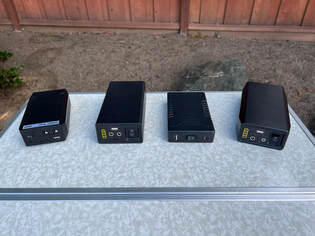 My original 8.3Ah Talentcell along with a 12.8Ah and 6Ah model and a 6.5Ah LiFePO4 model. My original 8.3Ah Talentcell along with a 12.8Ah and 6Ah model and a 6.5Ah LiFePO4 model. To confirm all of this I purchased 2 of the power banks utilizing the 3S design with NMC cells, a 6Ah and a 12.8Ah version added to the 8.3Ah version I already had. I also purchased a 6.5Ah Talentcell power bank using 4 LiFePO4 cells in series for comparison. I ran each of these through a full discharge cycle test after first fully charging them per the manufacturer's instructions. 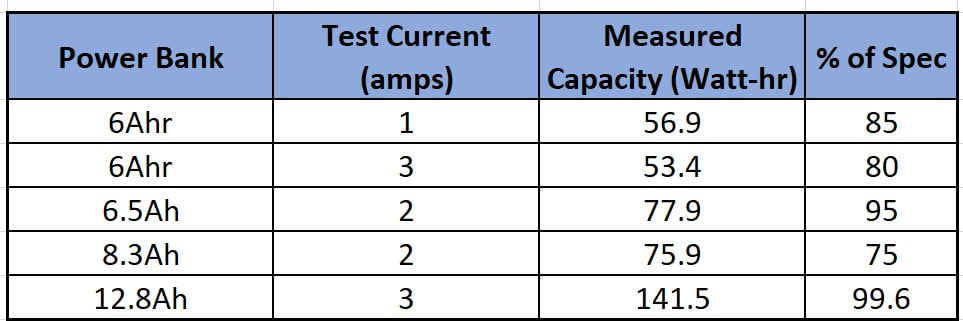 The measured capacities for each power bank are shown in the accompanying table. I used a load current at least half the rated current for each power bank in the capacity test to avoid stressing the battery. In the case of the 6Ah power bank I also used the maximum rated current of 3A to see if the measured capacity differed. Only the power bank with the 4S design using LiFePO4 cells met the rated capacity while the other 2 new power banks fell short by 5 and 15% respectively. I did not expect my 6 year old 8.3Ah power bank to match the rated capacity since I did not care for it well over its lifetime. More important than the rated capacities is the voltage versus capacity curves which are shown in the graph below. There are two curves for the 6Ah power bank since I measured this at both 1A and 3A loads. The curves show that while the no load voltage is 12.6V per the spec, the voltage drops below 12.0V as soon as a load is applied. For all 3 power banks the voltage drops below 11V with 70% of their rated capacity left which is quite amazing for a battery sold as a 12V battery. While lots of 12V equipment, including our typical astronomy gear, has a wide voltage tolerance, they are not designed to operate optimally when the voltage drops this low. This is clearly why the ZWO ASIAIR and AM3 and AM5 do not like these power banks. Even more amazing is the fact that these batteries drop below 10V with 30% of their capacity remaining. Even if your equipment works down to 10V, you are not getting the capacity you are paying for with these power banks. Looking at the 3A load curve for the 6Ah battery we can see if we push to the maximum current of the power bank the voltage drops even more precipitously and we can expect our equipment to quit or, at least, complain much sooner. So, why is this happening? Well I can only guess as to the reason that Talentcell uses a 3S design with these 9 different 12V power banks. First, with less cells they save space and weight which helps to keep the power banks small and portable which is their main selling feature. Also, by not using a 4S design they save on the cost of additional cells and the cost of the voltage regulator that would be required to drop the voltage into a typical 12V power supply range. It is the simple fact that they use 3 cells in series and not 4 with a voltage regulator that these are not really 12V power banks. On the other hand, the 4S designs with LiFePO4 perform perfectly as expected for a 12V battery and are the only ones that I recommend. As the voltage versus capacity curve below shows, the voltage stays above 12V for about 90% of its rated capacity with a load of 2A which is ~36W of power. If you push the power bank to its maximum current capacity of 5A the voltage drops more quickly but stays above 12V for ~66% of capacity and doesn't drop below 11V for 95% of the total capacity. Talentcell currently has one 4S model which uses LiFePO4 cells and has a capacity of 6.5Ah, which is model that I bought and tested and which be can found here. And if you need more capacity than that, here is a 12Ah LiFePO4 battery from Talentcell which is not a power bank but is still small enough to fit in the palm of a hand. ( Links are affiliate links). Talentcell is not the only one using a 3S design in their "12V" batteries. A short survey on Amazon found several other manufacturer's of power banks doing the same thing. And, amazingly to me, I found that even some of the portable power stations available such as the EBL 300Wh model specifies a DC output voltage of 9 - 12.6V just like the Talentcells with a 3S design while the EBL models 500 and 100 (which I tested and reported on here) specify a DC output voltage of 11.8 to 14V which is consistent with a 4S design with NMC cells and a voltage regulator. So my suggestion is to look carefully at the specifications before you buy.
If you want to see more on this topic, I made of video showing exactly how I tested the 4 Talentcell power banks which I bought and which you can find on my Youtube channel. These are the only TalentCell power banks that I would recommend, along with a 12Ah LiFePO4 battery if you need more power. Links are affiliate links which can earn a commission without any cost to you and help support this web site. Talentcell 12V LiFePO4 Battery 12.8V 6.5Ah 83.2Wh - amzn.to/3NYIPxD Talentcell 12V LiFePO4 Battery 153.6Wh 12.8V 12Ah: amzn.to/3SfDMM0 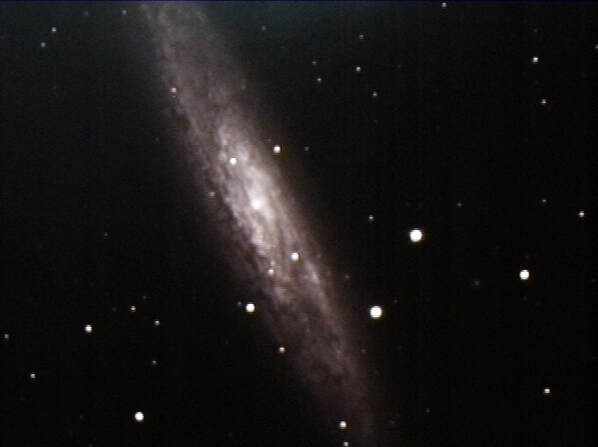 22 sec image of NGC253 Hyperstar on a 14" SCT 22 sec image of NGC253 Hyperstar on a 14" SCT If you own a Celestron SCT and do not already have a hyperstar adapter you should. What is hyperstar? It is a multi-element optical adapter which converts the focal ratio of an SCT from its native f/10 to f/2. Since the optical speed of a telescope is proportional to the square of its f-ratio, adding a hyperstar will increase the speed of an SCT by a factor of 25: speed ~ (10/2)^2 = 5^2 = 25. My first experience with hyperstar was back in 2015 when I first tried it on my 14" SCT to capture a breathtaking view of NGC253 the Sculptor Galaxy in just 22seconds. I was just blown away by what the hyperstar was able to capture in such a short time. Of course, smaller aperture telescopes will not produce such an image in the same time, but they will still have 25X faster optics resulting in amazing images in short times of their own right. Hyperstar is available for the 6", 8", 11" and 14" Celestron Edge and non-Edge SCTs and the 9.25" Edge version. It has been available for these models for some time. Just check the front of the Secondary mirror for the phrase "Fastar", where Fastar is the original Celestron name for this, to see if your older model is compatible. For those that do not say "Fastar" a conversion kit is available for all 6" through 14" models except the 9.25" model. 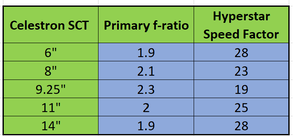 How does hyperstar work? An SCT consists of three optical elements, a corrector plate at the front, the primary mirror in the back and the secondary mirror in the center of the corrector. SCT primaries are spherical mirrors configured to a focal ratio of f/2. Actually the focal ratio of a Celestron SCT primary varies between f/1.9 and f/2.3 depending upon the model as shown in the accompanying table. For the sake of simplicity, lets stick with f/2 as our example. The secondary mirror is figured to a focal ratio of f/5 so the combined effect is a focal ratio of f/10, f/2 x f/5 = f/10. 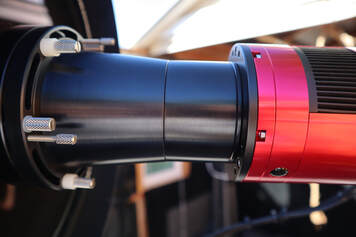 The camera adapter is seen between the hyperstar and the camera. The camera adapter is seen between the hyperstar and the camera. Hyperstar is installed by removing the secondary mirror and replacing it with the hyperstar compound lens. With no secondary the focal ratio is that of the primary mirror, or f/2. Obviously the hyperstar element can only be used with a camera for imaging, either for traditional astrophotography or electronically assisted astronomy, and not for visual observations. A camera is attached to the hyperstar via an adapter which is specific to the camera and hyperstar size. The light enters the SCT through the front corrector plate and reflects off the primary mirror just as it always does. But now, instead of reflecting off the secondary mirror back through the center of the primary and out the back of the SCT, it travels through the optical elements of the hyperstar and into the camera. The hyperstar is a multi-element lens/corrector which not only focuses the light onto the sensor in the camera, but also corrects for the spherical aberrations and field curvature which would be present without the corrective capability of the hyperstar. Images taken with the hyperstar should be sharp and flat across the field of view. Hyperstar can be used for both traditional astrophotography and electronically assisted astronomy. In both cases, the faster focal ratio enables more light to be collected in a given time compared to the SCT's native focal ratio of f/10. The results can be stunning as in the traditional astro photo of M31 shown below taken on a C11 with hyperstar for a total exposure time of 213 minutes using Pixinsight to combine and process hundreds of sub-frames. Similarly, amazing results can be obtained during live stacking and viewing during an EAA session as seen in the image of the Rosette Nebula taken with TSX's Live Stack feature stacking and stretching 120 x 5 sec sub-frames for a total of 10 minutes also using a C11 with hyperstar. 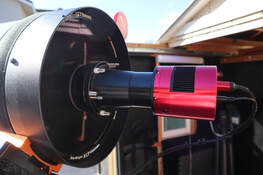 A C11 with hyperstar and an ASI2600MC A C11 with hyperstar and an ASI2600MC Installing Hyperstar Removing the secondary mirror from your SCT may sound scary but it really is a simple matter. I like to set the OTA at a slightly elevated angle so it is easy to reach the secondary and gravity will still help to keep it in place when its retaining ring is removed. The secondary slides out and can be placed into the protective holder which comes with the hyperstar. The hyperstar is threaded onto the secondary holder. But be careful not to over tighten the hyperstar. Finger tight is sufficient. I once got the hyperstar so tight that I had to remove the corrector plate to get it back off. You should not have this problem if you do not over tighten the hyperstar like I once did. After installing the hyperstar several times you will even feel comfortable doing this in the dark. The procedure should take only 5min or less. While hyperstar can weight as much as 3lbs for the 14" SCT it is not going to damage your corrector plate when handled carefully. An SCT corrector plate is much stronger than one may realize. Still, I would never transport an SCT with a hyperstar installed as the possibility of banging into the hyperstar is always present. Also, when covering the telescope using a hyperstar with an all weather cover just be careful that the cover does not snag on the hyperstar which protrudes from the OTA. I leave my hyperstar on for multiple days while in the field using a dew shield and cover over the hyperstar and correct which keeps dirt and dust off the corrector. At home I leave my hyperstar mounted on my SCT in the backyard observatory as long as I plan to work at f/2. There is really no need to remove and re-install hyperstar every day. 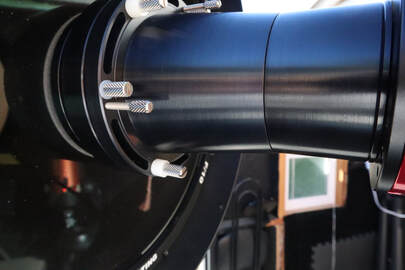 Push/Pull collimation pins at left and a rotation thumbscrew at bottom Push/Pull collimation pins at left and a rotation thumbscrew at bottom Hyperstar Collimation Just like the secondary mirror on an SCT, hyperstar will need to be collimated from time to time. Fortunately, hyperstar seems to hold collimation just as well as a secondary mirror so you should not expect to need to collimate any more frequently than you do without it. Also, you most likely will not need to re-collimate your scope when you put the secondary back since it is indexed to the optical axis with a pin which fits into a notch in the flange which holds the secondary. Hyperstar has 3 sets of push/pull pins located at 120 deg increments around the outside for the purpose of collimation. There are two strategies for initial collimation. The simplest takes advantage of the high precession machining of the two hyperstar mechanical bodies. Just adjust the push/pull pins so that both flanges of the hyperstar bodies are in contact all the way around and then tighten the pins. So long as these two flanges are parallel to one another and the corrector plate is aligned with the primary mirror you should have good collimation. Several folks have reported that this has worked for them so it is worth trying first. If you are not satisfied with the collimation with that approach you can use the second method. With this approach you will need 3 shims 30 to 40 mil thick. Metal stock of this type can be found at your local Ace hardware or online. I use Cu stock which I cut into 3 pieces long enough to fit between the two hyperstar flanges. With the shims spaced 120 degrees apart between the two hyperstar flanges, tighten the push/pull pins just enough so that you can barely pull the shims out. Make sure that you tighten pins are engaged so that the flanges do not come loose. Then, under the stars perform a collimation as you normally would using the push/pull pins in the same way as you would the 3 screws on the back of the secondary mirror. You will find that it is a lot easier to adjust the push/pull pins with your fingers. Just make sure they are all tight when you are satisfied with collimation. A very large variety of cameras are compatible with hyperstar including those from ZWO, QHY, ATIK, SBIG, etc. When ordering the hyperstar element you will need to specify the camera that you will use with it since a camera adapter is required to attach the camera to the hyperstar lens at the optimum distance from the camera sensor. 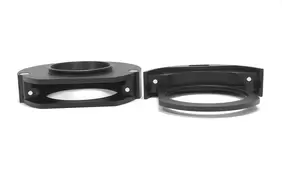 Hyperstar filter drawer and slider Hyperstar filter drawer and slider Using Hyperstar The hyperstar adapter has 3 thumbscrews which are designed to allow 360 degree rotation of the hyperstar so that you can adjust the orientation of your camera. Just loosen all three thumbscrews 1/4 turn, rotate the the outer body of the hyperstar to the desired orientation of the camera. Then tighten the thumbscrews to lock the camera orientation. Since these thumbscrews hold the two halves of the hyperstar together, you should never completely remove them. USB and power (if needed) cables are attached to the camera as usual. If you are using a dew shield you can either bring the cables out the front of the shield or, out the back of the shield if it has a notch in it. In either case tie off the cables so they do not drag. In some cases, the cables may produce diffraction spikes on bright stars just like the spider vanes on a Newtonian secondary. This can be minimized by avoiding running the cables in a straight line across the front of the OTA. The hyperstar camera adapter is threaded inside so that a filter can be attached. This works well if you intend to use only a single filter, such as a light pollution filter, a UV-IR filter or a multi-band filter during you imaging session. Just unscrew the front piece on the adapter, screw in the filter and screw the adapter/filter combination back on. Then attach the camera. If you want to change filters during a session you will need a filter drawer for the hyperstar. The filter drawer screws onto a separate hyperstar adapter such that the combination provides the correct backspacing for your camera. Everything else in an imaging or EAA session will be the same as if you did not have the hyperstar except it will require much less time to be able to see DSOs compared to operating at f/10. Wide Field Since the hyperstar reduces the focal ratio to f/2 but does not reduce the aperture of the telescope, the field of view will be much wider. In fact, the field of view will also be 25X larger compared to f/10, 5X in each axis of the camera sensor. This is precisely how the hyperstar speeds up imaging. To understand this let's take a look at the difference in image scales at f/10 and f/2. Image scale depends upon the size of the pixels in the camera and the focal length of the telescope. It is defined by the following equation: Image Scale (arc-sec/pixel) = 205 x pixel size (microns) / focal length (mm) So, for the same camera, the image scale varies inversely with the focal length. In other words, the image scale increases as the focal length gets smaller. Adding the hyperstar reduces the focal length proportional to the reduction in focal ratio. For the C11 discussed above the focal length is reduced from its native 2794mm to 559mm with hyperstar. The image scale is then reduced by the same factor of 5 across the x and y axis of the camera chip. This means that each pixel is collecting light from an area of the sky 25X larger with the hyperstar than without the hyperstar which is why the exposure time is reduced. Keep in mind that with the wider field of view the resolution is now reduced by the same amount. But since seeing conditions usually dominate image resolution stars and most CMOS cameras used for astronomy have sensors with pixels smaller than 4microns on a side the image quality will still be excellent, even if you zoom in on the image. Summary
Hyperstar is certainly expensive costing just under $1000 for an 8" SCT and more for larger apertures. However it should be viewed as turning your f/10 SCT into a completely new telescope with a focal ratio at least 4X faster than the fastest refractors available while maintaining an aperture many times larger than a refractor. Think of it as investing in an entirely new scope but without having to purchase a new set of accessories (finder, dew heater, focuser, etc.). As the few images shared here show, hyperstar can produce incredible images in real time and is well suited to capturing more of the larger DSOs. If you want to see more about the amazing hyperstar check out my hyperstar YouTube video Links are affiliate links which can earn a commission without any cost to you. Please consider using them to help support this web site. Hyperstar is available from HighPoint Scientific bit.ly/3RO8vgv  Jackery Solar Saga 100, EBL Apollo 100 and Bioenno Power 100W Solar Panels Jackery Solar Saga 100, EBL Apollo 100 and Bioenno Power 100W Solar Panels I have previously reported on my results testing several different portable power stations from Jackery, EBL and Bluetti along with LIFePO4 batteries from Li Time (formerly Ampere Time), Bioenno Power and Battleborn to power my astronomy rig out in the field. Typically we travel to distant dark sites for multiple nights under the stars and most likely will need some way to recharge a power station or battery during the day. Portable solar panels are a great way to do this when AC power is not available. So in this blog I will review three 100W portable solar panels that I have been using over the last few years. While the panels were sent to me by their suppliers at no cost to me I am under no obligation to provide a positive review and/or avoid negative comments if they are warranted. None of the suppliers has seen this review before it was posted. So here we go. The three solar panels are the Jackery Solar Saga 100, the EBL Solar Apollo 100 and a 100W panel from Bioenno Power. Each is designed for a maximum of 100W of output power, but anyone already familiar with solar panels know that the 100W specification is only achieved under ideal laboratory conditions with a well controlled and uniform light intensity at the optimum angle and at room temperature. In real world conditions, expect to get ~70 to 90% of the specified maximum rating out of any solar panel. All 3 of the panels in this review use monocyrstalline silicon photo voltaic chips which are the most efficient solar panels on the market with an efficiency of 24%. 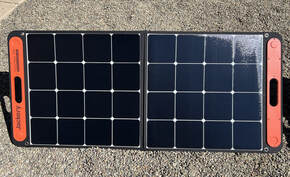 Jackery Solar Saga 100 The Jackery Solar Saga 100 is highly rated but is one of the more expensive panels at $269 as of this blog. The Jackery has an output voltage of 18V at 5.55A which works out to 99.9W. The panel is fairly large with an unfolded dimension of 48" x 21". When folded it reduces to 24" x 21" and 2" thick which makes it fairly easy to pack away for travel. It has convenient built in carrying handles and magnets to help keep the two halves together when closed. Jackery claims that the panel weighs only 5.5lbs but I measured it to actually be 9lbs, which is considerably more but not difficult to carry around. A big plus of the Jackery compared to the other panels is the two large, 6.25" wide, kickstands which make it easy to set up and keep both halves of the panel at the same angle to the sun. The panel is coated with a plastic material to make it more durable and easier to clean and is splash resistant but not waterproof. I found the overall build quality to be quite good and the panels (I have 2 of them) have stood up quite well to occasional use over the last 2+ years. The electrical connection is inside a zippered case and includes a single 10ft long 16AWG cable with an 8MM male plug designed to be plug compatible with Jackery's portable power stations. If you have another brand of power station which does not use the 8mm connection you can get an adapter to connect the Jackery panel to it. I like the fact that they provide a long cable which allows flexibility in positioning he power station or battery being charged. It is best to keep the power station or battery from direct sun exposure and I typically place it behind the panel. I also like the fact that the input cable is strain relieved at the point that it connects to the panel. There are two USB ports ( 5V/3A USBC 5V/2.4A USBA) at the strain relief which allow direct charging of USB devices by the panel such as your phone, laptop, tablet, camera, etc. The Jackery solar panel comes with a 2 year warranty and technical support is available in Fremont, California so you do not have to email China for help. I will note that one of the 2 Jackery panels sent to me did fail after about 1 year of use for no apparent reason and was promptly replaced with a new panel. 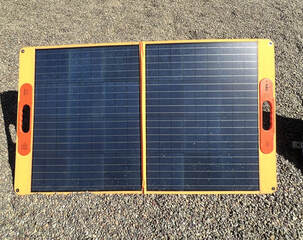 EBL Solar Apollo While EBL is not as well known of a brand in the power station and solar panel business, it has been around since the 90s as a manufacturer of alkaline, NiCd and other types of batteries and chargers. A major appeal of the EBL Solar Apollo 100 is that it is one of the least expensive 100W panels at $149 which is almost half the price of the Jackery. The output voltage of the EBL panel is 20V at 5A which works out to 100W. The EBL is about 23% larger than the Jackery when fully open with an unfolded dimension of 46' x 26.75". It is only slightly larger than the Jackery when folded with a dimension of 26.75 x 23 but that still makes it less convenient to pack for travel compared to the Jackery. It also has convenient built in carrying handles and magnets to help keep the two halves together when closed. The EBL panel weighs 9.5lbs. I wish EBL had made the two kickstands wider like the Jackery as theirs are only 4.25" wide which makes it a little bit harder to support given the larger overall dimensions of the panel. This panel is also coated with a plastic material to make it more durable and easier to clean and is splash resistant but not waterproof. Just like the Jackery the EBL has a zippered pouch which houses the output cables connected to the panel. However, the EBL panel uses a pair of 3ft cables with MC4 connectors on the ends. I found the short cables to be stiff and therefore difficult to manipulate. But they do supply two additional flexible adapter cables, one which converts from the MC4 connectors to a Power Pole connector and the other to a 5.5mm x 2.1mm connector. Plus they include 5.5mm x 2.1mm to 8mm, 5.5mm x 2.1mm to 5.5mm x 2.5mm, and 5.5mm x 2.1mm to 3.5mm x 1.5mm adapters so that the Apollo panel can be connected to pretty much any brand of portable power station. Unlike the Jackery, the Solar Apollo panel does not have a USB charging port. But much more importantly it does not have a rigid strain relief where the cable connects internally to the panel like the Jackery. Instead there is a simple loop which was not enough to prevent one of the cables on the panel from partially coming out of its internal connection exposing a bare lead. The panel comes with a 1 year warranty and technical support is available only through China. 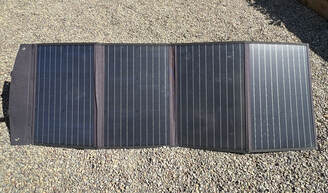 Bioenno Power The Bioenno Power solar panel is designed very differently from the other two panels. It is a quad -fold panel which means that it folds down to a much smaller package measuring 20.5" x 14.5" which makes it easier than either of the other two panels to pack in a smaller space. Unfolder it is the longest of the panels at 57" x 20.5". I found the two 2" wide kickstands totally inadequate to set up the panel so that all four segments are aligned in the same plane. This would be much better if that had 3 or 4 kickstands at least 3" wide. It also has a convenient carrying handle and clips to hold the panel shut. The Bioenno panel weights slightly more than the other two at 10lbs. This panel is priced between the other two at $210 and it has an output voltage of 18V with 5.56A. Just like the other two panels the cable sits inside a zippered compartment. Unfortunately, the cable is even shorter than the one provided by EBL which means that you will definitely need to buy an extension cable to have any practical chance to connect the panel to a power station. But, since the Bioenno Power uses a non-standard 50A Anderson Power Pole connector you would certainly need an adapter cable anyway. Bioenno Power sells an adapter cable which converts to the much more common 40A Anderson Power Pole connector. Like the EBL the Bioenno Power does not have a USB charging port but does have a solid strain relief like the Jackery . 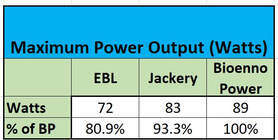 Charging Tests I performed two different charging tests on each panel. The first test was designed to determine the maximum output power of each panel on a clear sunny day in June with the sun at its peak in the sky for the day. Each panel was supported by a piece of plywood to hold it flat in a plane and tilted in altitude and rotated in zenith relative the the sun until a maxim input reading was obtained on a Jackery 1000 portable power station's input meter. The Bioenno Power produced the highest maximum output of 89W, while the Jackery had a maximum of 83W and the EBL panel produced the lowest power output of 72W. As discussed in the beginning we see clearly that the outputs are not 100W. The Bioenno Power panel outperformed the other two with the outputs of the Jackery at ~93% and the EBL at only ~81% of the Bioenno Power's output. 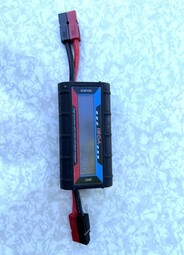 The next test was a 3 hours cumulative power output test. Here I measured the output power produced over a 3 hour period on a clear sunny day in June starting 1.5 hours before the sun peaked in altitude through 1.5hrs after the peak. Thus the panels were exposed to the maximum solar radiation possible on that day. To measure the output power I used identical in-line DC power meters which measure the power, voltage, current, Ah and Wh produced. I needed something for the solar panels to charge during the tests but I did not have 3 identical power stations which would have made the test very simple. Instead, I used my Jackery 1000 and EBL 1000 portable power stations as the loads with the DC power meters between the panels and the power stations. Since the charging circuits on the two power stations may behave differently I had each panel charge each of the two power stations for half the 3 hour time so as to accommodate any variation in power because of differences in the power stations. So each panel charged each power station for 1.5hrs during the test. Now, 3 panels into 2 power stations does not divide evenly. So, I ran the test in pairs, testing all three combinations of pairs over 3 days with clear skies from 11:30AM until 2:30PM swapping power stations and in-line meters at the midpoint of 1PM. Test Order: Day 1: Jackery Solar Saga vs. EBL Apollo Day 2 EBL vs Bioenno Power Day 3 Jackery vs. Bioenno Power The results are shared in Table 2 below which shows that the Jackery produced 35Wh, or 16%, more energy than the EBL Apollo over the 3 hours on day 1. The Bioenno Power panel produced 32.5Wh, or 18%, more energy on day 2 than the EBL panel. And on day 3 the Bioenno Power Panel produced 9.7Wh, or 6%, more energy than the Jackery solar panel. 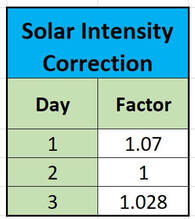 Table 2. Solar Correction Factors Table 2. Solar Correction Factors Now, to be fair, even though the measurements were done at the same times on all 3 days, and even though all 3 days were clear sunny days, we cannot be certain that the flux of photons was the same each day. But there is a way to correct for any differences in the amount of solar radiation over the 3 days. We can normalize the numbers to the one of the panels on one of the days, in this case, the Bioenno Power output on Day 2. Since we have each panel tested on 2 days we can take advantage of the readings on the same panel from day to day to correct for differences in solar radiation. If we take the ratio of the Bioenno Power reading on Day 2 to Day 3 we get 121.1 / 117.6 = 1.03, which means that the solar radiation on Day 2 was 3% higher than on Day 3. Next we can scale the EBL measurements from Day 2 and Day 1 to get 101.4 / 94.5 = 1.07 which shows that the solar radiation on Day 2 was 7% higher than on Day 1. Using these Solar Intensity Correction factors we can scale the Day 1 and Day 3 readings to the readings on Day 2 using 1.07 to scale Day 1 and 1.03 to Scale Day 3 as shown in Table 2. 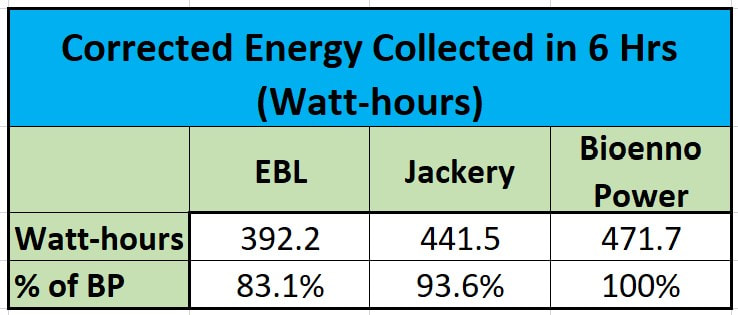 Table 3. Energy Output of each solar panel over 2 days (6hrs) corrected for day to day solar radiance differences Table 3. Energy Output of each solar panel over 2 days (6hrs) corrected for day to day solar radiance differences The result is the corrected Table 3 shown below. This shows that the panels collected a total of 392 to 471 Watt-hours of energy over a 6 hour period of peak solar intensity. The Bioenno Power panel collected the most energy at 471Wh. If the panel had actually output 100W during those 6 hours we would have expected 600Wh of energy. Instead, we got 78.5% of the ideal expectation. Now keep in mind, the panels lay flat on the ground so they we not at the optimum angle to the sun throughout the data collection period. I am certain if I had tilted the panel for its maximum output and adjusted it multiple times over the course of the 6 hour test we would see something in the high 80% range as we saw in the maximum output test above. The Jackey panel produced less energy over the same time at 441.5Wh which is just under 94% of what the Bioenno Power produced. This is very consistent with the maximum output test discussed above. The EBL panel came in significantly behind the other two panels at 392.2Wh which is only 83% of what the Bioenno Power panel produced. This is also in line with the maximum output test. Out of curiosity I measured the area of the solar cells on each panel and found the following: Jackery Solar Cell Area: 820 sq-inches EBL Solar Cell Area: 950 sq-inches Bioenno Power Solar Cell Area: 951 sq-inches I was not surprised to see that the area of the Bioenno Power panel is greater than that of the Jackery. The ratio of the areas is 86% which explains why the Bioenno Power produces more output than the Jackery, although I am surprised that the Jackery puts out 93% of the power of the Bioenno panel given the size differential. What surprises me more is that the EBL panel has the same collection area as the Bioenno Power panel, yet it produces only 83% of the power. While all the panel manufacturers claim efficiencies of 24% we see that the overall efficiency of the Jackery appears to be higher than the other 2. If we divide the output in Table 3 for each panel by the measured solar cell area we get: Jackery : 0.54Wh/sq-inch EBL: 0.41Wh/sq-inch Bioenno: 0.50Wh/sq-inch Summary
The Bioenno Power panel is the clear winner in terms of output and overall compactness of design. Its only detractors are the two small kickstands which are not quite ideal for the length of the unfolded panel and the short cable with the non-standard connector. Although the Jackery produced slightly less output compared to the Bioenno Power panel the design is easier to handle with just two panels instead of four, wide kickstands for excellent support, a long and flexible output cable long and USB charging ports. The output of the EBL panel is quite surprising given the area of the solar cells. While the panel is much less expensive than the other two, both the lower output power and lack of an adequate strain relief on the cable input to the panel makes this panel much less attractive. You can find a video version of this review on my YouTube channel here www.youtube.com/watch?v=0LmzAM98sAQ Amazon links above are affiliate links which can earn a small commission at no cost to you. Using these helps to support this web site. Jackery 100W Solar Panel amzn.to/3rR3wmZ EBL 100W Solar Panel amzn.to/3s1wtMX Bioenno Power 100W Solar Panel www.bioennopower.com/collections/solar-controllers/products/bioenno-power-bsp-100-lite-model-100-watt-foldable-solar-panel 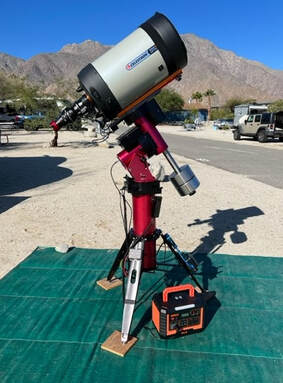 EBL Voyager 1000Wh Portable Power Station EBL Voyager 1000Wh Portable Power Station Lithium based power sources like Li ion batteries from Li Time, Bioenno Power and Chins along with portable power stations from companies like Jackery, EBL and Bluetti are quickly replacing lead acid batteries when it comes to powering astronomy setups away from AC power. Lithium batteries offer several important advantages over traditional lead acid batteries. First, they have much higher energy densities making them half the weight of a similar capacity lead acid battery. Second, while lead acid batteries should not be discharged more than 50-60% of their rated capacities to avoid damage including loss of capacity and ultimately complete failure, lithium batteries can safely be fully discharged without damage (more on this later). Third, while the voltage of a lead acid battery falls off steeply with depth of discharge, reaching ~12.05V at 50% DOD, lithium batteries have a much flatter voltage vs SOC curve dropping below 12.0V at ~95% DOD. Fourth, lithium batteries have a low self discharge rate of 2-3% per month which means they only need to be recharged once every 3-6 months when in storage. Also, Lithium batteries do not suffer from the memory effect of other battery chemistries so it is not necessary to fully recharge them after use. Finally, lithium batteries will supply more of their rated capacity in cold temperatures compared to lead acid batteries with some estimates indicating as much as 2X the capacity compared to lead acid below 32F. However, with this new source of energy comes a lot of confusion and downright wrong information on the astronomy forums. To correct this misinformation I decided it was time to provide a review of the basics of lithium battery technology and to correct the most common misconceptions that I see posted on these forums. Over the last three years I have immersed myself in lithium technology by both doing a literature search on the subject and by talking directly with multiple suppliers of lithium batteries and power stations to gain a fuller understanding of the technology and manufacturing methods. I visited the Battleborn factory technical team and toured the factory floor to see and hear how they design, test and assemble their batteries. Most importantly, working with multiple suppliers I have conducted my own testing of LiFePO4 batteries from 6 different vendors to collect data for myself to compare to manufacturer's specifications and to test out some common misconceptions. This Blog is a summary of the entirety of my efforts in this regard. 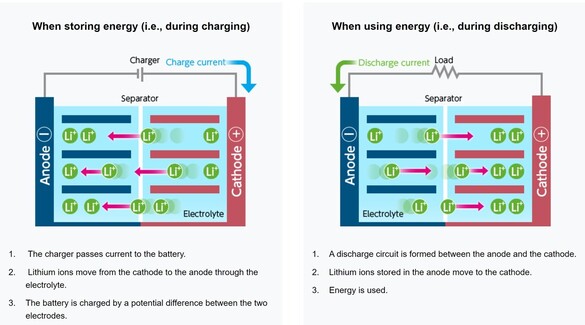 Li ion battery charge and discharge cycles from Toshiba Li ion battery charge and discharge cycles from Toshiba Lithium Battery Basics There are many different lithium battery chemistries that have been developed, each with their own specific advantages and disadvantages. These include LiCoO2, LiMn2O4, LiNiMnCoO2 (NMC), LiFePO4 (LFP), LiNixCoyAlzO3 (NCA) along with other less common chemistries. One of the first misconceptions is that Li ion is a specific type of lithium chemistry when in fact it is simply the general name given to all of the above Li chemistries. Li ion batteries are so called because they use Li ions to generate electric current. Like lead acid batteries, Li ion batteries consist of multiple cells in series to achieve the desired voltage and capacity of the battery. Li ion cells consist of a graphite anode, a lithium metal oxide cathode (such as the ones listed above), a separator, an electrolyte and a casing. During discharge the Li ions flow from the anode to the cathode releasing electrons which supply power to the load. During the charging cycle, Li ions flow across the separator to interstitial positions between the planes of carbon in the graphite anode via a process called intercalation. The metal oxide cathode material is the main difference from one Li battery chemistry to another. Unlike lead acid batteries, Li ion batteries have an internal electronic component called a Battery Management System (BMS) that is designed to make sure that the battery operates safely and is protected from unsafe or potential damaging situations. The BMS has multiple functions. It protects the cells from over voltage, over charging, over discharging, over current, and short circuits. It also balances the internal cell voltages to keep the cells in balance so that they all are charged to the same voltage. Cell balancing happens at the high end of the charge cycle which is why you will find it takes much longer to charge a Li ion battery the last few percentage of the state of charge (SOC) than it does through the bulk of the charging capacity. It is also why it is important to use a Li charger which will charge the battery to the correct voltage which is higher than the typical charging voltage with a lead acid charger. Also, on many batteries but not all, there are one or more internal temperature sensors which are connected to the BMS to stop it from charging or discharging when outside the manufacturer's specified temperature operation limits. If the battery does not have this feature it is up to the individual to make sure that the battery is not charged below 32F. 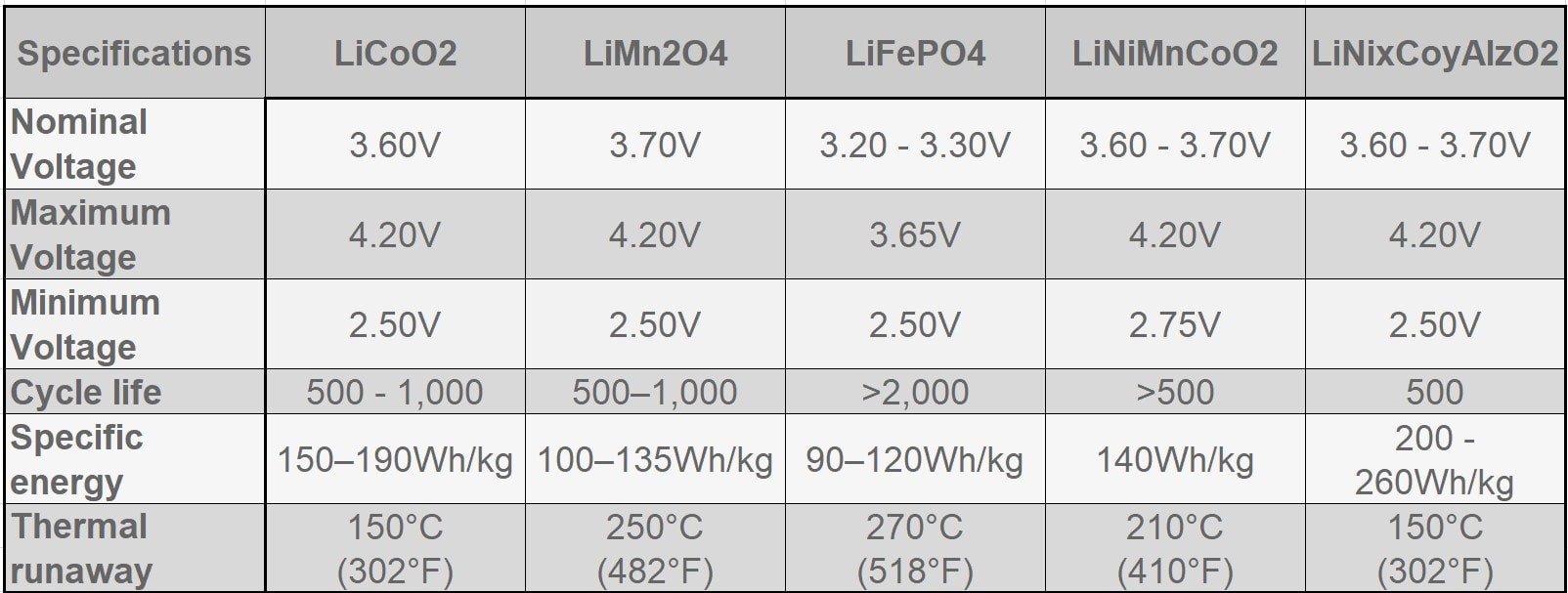 Key lithium chemistry properties taken from Battery University & Other Sites Key lithium chemistry properties taken from Battery University & Other Sites The two most common Li ion chemistries found in the batteries and power stations of interest to us are LiFePO4 and LiNiMnCoO2 which we will focus on in this Blog. Looking at the table below, one can see that LiFePO4 has a nominal voltage of 3.2V which means that 4 cells in series produce a battery with a voltage of 12.8V, ideal for a "12V battery." A 100Ah LiFePO4 battery will typically have 4 3.2V cells with 100Ah capacity each in series to achieve both the specified voltage and Ah capacity. LiFePO4 also has the highest thermal runaway temperature among the most common lithium chemistries. It also has the highest discharge cycle life with 2K to 5K full discharge cycles. This is why you will find that LiFePO4 is used in lithium batteries designed to replace 12V lead acid batteries. LiNiMnCoO2 has an energy density as much as ~2X that of LiFePO4 cells. This is why LiNiMnCoO2 is commonly found in applications where weight is critical including ebikes, power tools, electric cars and portable power stations. While its thermal runaway temperature is lower than LiFePO4, it is still quite high. With a nominal cell voltage of 3.6V there is no way to combine cells to achieve a voltage consistent with a 12V battery. For instance, 3 cells in series produce 10.8V which is too low while 4 in series produce 14.4V which is too high for 12V systems. This is why portable power stations with LiNIMnCoO2 cells have voltage regulation. If you were to look inside one you might find 4, 6 or more cells in series which would produce voltages of 14.4V, 21.6V, or higher which are then regulated to provide an output voltage of ~12.8V consistent with other 12V power supplies. Typical voltage versus depth of discharge data show the key differences among the different power sources. Lead acid batteries have a relatively steep discharge curve with the output voltage falling below 12V at 40% capacity. LiFePO4 on the other hand has a slow voltage drop remaining above 12.0V until 95% of the capacity has been used. Since LiNiMnCoO2 requires voltage regulation as found in power stations like the Jackery and other brands, the voltage remains flat all the way until the internal battery BMS shuts off the output with 0% capacity remaining. Lithium Batteries vs Power Stations When it comes to Li ion power there are two very different options. The first is a stand alone Li battery which is designed and packaged to replace a lead acid battery. As such, it looks identical to a lead acid battery with the lithium cells enclosed in an ABS case similar in size to an equivalent capacity lead acid battery. It has a positive and negative terminal just like a lead acid battery. As described above, the Li battery also has a BMS to provide for safe operation and long life of the battery. Stand alone batteries use LiFePO4 and come in many different capacities from a few Ahs to hundreds of Ahs. The second Li power option is a Li ion power station. A power station not only provides 12V dc power, but also has an internal pure sine wave inverter to provide AC power via one or more outlets. It also has multiple powered USB ports to charge phones, tablets and even laptops. All portable power stations that I have seen come with a cigarette output port with a maximum current of 10A. Some come with additional dc power ports with a variety of connector types (5.5 x 2.1mm, 5.5 x 2.5mm, 6.5 x 4.1mm, etc.) usually rated 3A - 7AA. Power stations come with an AC charger to recharge the device from a wall outlet. They also have an internal solar charge controller which accepts input from one or more solar panels (not typically included) to recharge the power station via the sun. Power stations include an internal meter and display to show the state of charge (SOC) and power during discharge and recharge operations. Power stations also have an internal BMS which performs the same functions as in the LiFePO4 battery. Like the stand alone LiFePO4 battery discussed above, power stations come in a variety of capacities typically stated in Wh from ~200 to over 2k Wh. Most power stations use LiNiMnCoO2 cells due to their higher energy density which helps keep the weight down since power stations are meant to be portable devices. There are however, several power stations which use LiFePO4 cells. With LINiMnCoO2, the dc output is regulated since, as discussed above, the cell voltages do not add up to 12.8V like they do with LiFePO4. Lithium Ion Cycle Life and Calendar Life One of the biggest myths of Li ion batteries is the one which says you cannot discharge a Li ion battery more than 80% or 90% without damaging it. This is patently false. Li ion batteries and power stations are designed to be fully discharged. That means you have access to 100% of the rated capacity without risk of damaging the individual cells inside and without degrading the rated number of discharge cycles of the battery or power station. For instance, if you check the web sites for Battleborn, Ampere Time (re-branded as Li Time), Chins or Lithionics you will see that they all specify their cycle life in terms of 100% depth of discharge (DOD). Battleborn specifies 3-5K cycles, Ampere Time 4K + cycles, Chins 2K+, and Lithionics 2K cycles. And, after that the battery will still retain 75 - 80% of its original capacity. In the power station category Jackery with LiNiMnCoO2 cells specifies >500 full discharge cycles after which one can expect 80% of the original capacity. In contrast, as most people know, a lead acid battery should not be discharged below 40% of its capacity otherwise sulfates will form on the plates reducing capacity and eventually shorting out the cells. In contrast, the BMS inside Li ion batteries monitors the individual cell voltages inside to make sure that no cell's voltage drops below the minimum value shown in the table above, typically 2.5V. When any cell reaches the minimum the BMS shuts the battery down to prevent cell damage. So the battery is designed to provide its full rated capacity without any cell's voltage dropping below this safe minimum voltage. Now it is true that you can extend the cycle life by not fully discharging a Li ion battery. For instance, discharging a Li ion battery to only 50% DOD can improve the cycle life by almost a factor of 3. But then you would need to purchase and handle two batteries instead of one to provide the power you need for your equipment. A good compromise might be to size the battery you purchase such that you only need to discharge it by 80% - 90% just to be on the conservative side. Calendar life of a battery refers to how long it will last if stored under ideal conditions of state of charge, temperature and humidity. This is independent from cycle life. Typical calendar lifetimes are quoted as 10 years, although Li ion batteries have not been around long enough for a significant amount of data to be collected to confirm this estimate. By contrast, the calendar life of a lead acid battery is usually quoted as 4 -6 years. The main mechanism for calendar aging is the growth of passivation layers at the interfaces between the electrolyte and the cathode and anode. This growth depletes the amount of available cyclable lithium. Both high temperatures and high SOC can accelerate calendar life degradation. 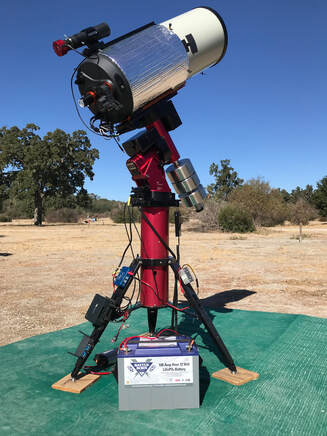 Battleborn 100Ah LiFePO4 Battery Battleborn 100Ah LiFePO4 Battery Operating Temperatures All battery types have specific temperature ranges of operation and Li is no different. Typically, lithium batteries can be discharged safely down to -4F (-20C) and up to 120F (49C) to 140F (60C) depending upon the manufacturer's spec. Charging of lithium ion batteries is only permissible at temperatures above 32F (0C) unless the battery has an internal heater and temperature sensor which will allow charging below an ambient temperature of 32F but not below an internal temperature of 32F. Charging a Li ion battery bellow 32F will cause damage to the internal cells by causing some of the Li ions to plate as Li metal on the anode surface rather than intercalating between the carbon planes in the graphite anode. This happens because there is not enough thermal energy to drive the Li ions into the graphite structure. This reduces the capacity of the battery and if done too often can lead to the formation of Li metal dendrites which short across the separator to the cathode causing catastrophic failure of the battery. Li ion batteries also have a maximum temperature at which they can be charged which ranges from 113F (45C) to 131F (55C) depending upon the manufacturer's spec. The battery itself produces heat during discharge which combined with a high ambient temperature can cause swelling of the cell and venting. A battery with an internal temperature sensor connected to the BMS will prevent charging and discharging out of the battery's specified temperature range. It is also possible to damage a Li ion battery by trying to charge it too fast with too high of a current. Manufacturer's spec the charging current between 0.2 and 0.5C meaning, 20A or 50A for a 100Ah battery (10 to 25A for a 50Ah battery, etc.). Once again the reason has to do with the mobility of the Li ions. If they arrive at the anode too quickly, i.e. at too high a charging current, they can begin to pile up at the surface of the anode instead of diffusing into the graphite lattice. Check the manufacturer's specification for temperatures of operation and charging and discharging maximum currents. Another common misconception about Li ion batteries is that they perform poorly at cold temperatures. The fact is that all battery chemistries including lead acid have less capacity at temperatures below freezing. This is simply the result of the fact that batteries work by the process of diffusion from one electrode to the other. Diffusion rates are a function of temperature with rates decreasing significantly at low temperatures. However, as indicated above, Li ion batteries retain more of their capacity at low temperatures than lead acid batteries, hence they actually perform better at low temperatures with the caveat that they cannot be charged below freezing. Charging & Storing a Li Battery Many people make the mistake of trying to use a lead acid battery charger to re-charge a Li battery. The problem with this is that a lead acid battery charger will stop charging a Li battery before it reaches the required 14.4 to 14.8V required to fully charge the cells inside. This results in charging the battery to only 70 - 80% of its capacity. Not only that, but the typical BMS will not perform the important function of cell balancing until the top end voltage is reached. Over time, this will degrade the overall capacity of the battery even if you later use a charger capable of charging to 14.4V. Another source of confusion when charging a Li battery can result when the battery is fully discharged (SOC at 0%) to the point that the BMS shuts down the output. If you put a volt meter on the battery after the BMS has shut it down you will measure a voltage of 0V. Many battery chargers, including some with a Li battery setting, will not charge the battery if they see 0V. Make sure that the charger is one which specifies 0V charging like this one from Li Time or similar. A trick to get a non 0V charger to work (still needs to have a Li setting) is to connect any 12V battery or jump starter to the Li battery momentarily to "wake up" the BMS. It only takes a momentary contact making sure to connect the positives to each other and the negatives to each other just like jump starting a car battery. It is always important to keep a Li ion battery from getting too hot and for we astronomers that means keeping out of direct sunlight on the viewing field. This is especially true when charging the battery as internal heat is produced when charging (also when discharging) a Li battery due to its internal resistance. The added thermal burden of high ambient temperatures and direct sunlight can raise the internal battery temperature and result in cell damage. I always tuck my battery or power station in the shield behind my solar panels to keep it cooler. If a Li battery needs to be stored for an extended period most manufacturer's suggest storing it at a 50% SOC although at least one company, Battleborn, says to store it at a 100% SOC. Based upon the fact that published literature show that a high SOC is more stressful to a Li battery it is probably best to follow the lower SOC suggestion of 50%. Because Li batteries have a low self-discharge rate of 2-3% per month they only need to be recharged every 3 - 6 months. To make sure that the BMS balances the internal cells you would need to recharge it to 100% SOC and then discharge it to the whatever SOC you plan to store it at, say 50%. Li Battery Safety While lead acid batteries can cause fires and explode if not properly handled, lithium batteries have received a lot more media attention for dramatic failures in recent years. The term "venting with flame" was coined to describe thermal runaway events where the can containing the cell components breaks and fire escapes. Despite all the media attention, lithium batteries are quite safe when handled and operated properly. The Occupational Health and Safety Administration points out that lithium batteries are "generally safe and unlikely to fail, but only so long are there are no defects and the batteries are operated safely." Lithium batteries fail for one of several reasons. Manufacturing defects like the presence of tiny metal particles in Sony batteries in the 90s can cause an internal short and resulting failure. Manufacturing processes have improved greatly since then, but it is probably a good idea to purchase a lithium battery from a supplier who has been around for a while and has a good reputation as one would expect them to source high quality components and use proper assembly and testing procedures. Like lead acid batteries, lithium batteries can fail when damaged from falls, punctures or excessive vibrations. They can also fail from improper use such as charging below the low temperature cut-off, charging with too high of a current, a short circuit or excessive temperatures. The internal BMS is a major safety feature to help insure safe operation. But it can only prevent operation outside the specified temperature limits if it has one or more internal temperature sensors which not all lithium batteries have. In summary, if handled and operated properly a quality lithium battery should not be any more dangerous than a lead acid battery. Many of the Li ion battery failures are from devices like cells phones, tablets and laptops which use LiCoO2 as the cathode material because it has one of the highest energy densities. However, it also has the lowest thermal runaway temperature as well. One should not draw generalized conclusions about the safety of LiFePO4 and LiNiMnCoO2 batteries and power stations from failures in devices using LiCoO2. Lithium vs Lead Acid Battery Cost Comparison Another popular misconception is that Li ion batteries cost more, even much more, than lead acid batteries. The fact is the total cost of a lithium battery is much less the cost of an AGM battery. A check on Amazon shows 100Ah AGM deep cycle batteries selling for $165 to $204 while name brand LiFePO4 batteries from Chins and Li Time sell for $320 and $350, respectively. Knowing that lead acid batteries should not be discharged more than 60% while LiFePO4 batteries can be safely discharged 100% one would need 1.7 100Ah AGM batteries to supply the equivalent energy as a single LiFePO4 battery. So the actual up front cost comparison is $3.20 to $3.50 per Ah for LiFePO4 versus $2.75 to $3.40per Ah for AGM. Now we must take into account the useable life of each battery type. For LiFePO4 the most conservative estimate is 2,000 full discharge cycles while the most optimistic estimate for an AGM is 750 cycles. Taking this into account the total cost per Ah over the full cycle life is less than 0.2 cents for LiFePO4 and 0.4 cents for an AGM battery. So a LiFePO4 battery costs less than half that of an AGM battery over the full expected cycle life of the battery. Another way to look at this is the calendar life of the battery. As we mentioned above, the calendar life of a LiFePO4 battery is 10 years while that of an AGM battery is ~5 years, nearly half as long. So, no matter how you compare the two, a LiFePO4 battery is a better value than a lead acid AGM battery these days. Now the cost comparison is different when we talk about Li power stations like those from Jackery and EBL. The EBL 1000Wh power station sells for $490, is expected to provide 500 full discharge cycles and provides 83Ah per cycle. The total cost comes to 1.2 cents per Ah. Power stations are more expensive options compared to stand alone LiFePO4 batteries because they provide many more features besides dc power including pure sine wave inverted AC power, multiple USB power ports, an internal solar charge controller, internal meter and display, etc. Summary and Conclusions As we have seen, Li ion batteries have many advantages over lead acid batteries which is why they are fast becoming the batteries of choice for amateur astronomers. A 100Ah LiFePO4 battery with a capacity of 1280Wh can be expected to provide power to an astrophotography or Electronically Assisted Astronomy setup requiring 64W of power (5Ah) for a total of ~20hrs before needing to be recharged. They are in fact cheaper than lead acid and perform better than lead acid at all temperatures. When handled and operated correctly Li ion batteries are safe. To achieve the maximum useable life and capacity, as well as, prevent damage to the battery or even a catastrophic failure, always follow the manufacturer's recommended specifications and operating instructions. Links are affiliate links which help to support this web site at no cost to you. If you purchase a lithium battery or portable power station as a result of reading this Blog I ask that you please use my links for your purchase.
Get 3% Off any LiFePO4 battery from Li Time using coupon code CURTISM and the Li Time link below LiFePO4 Batteries Li Time (formerly Ampere Time) Amazon amzn.to/3M9sbv8 Li Time 's Web site www.amperetime.com/?ref=VlYrkkdj Chins amzn.to/3nEZBYc Dakota Lithium amzn.to/3nDhp6f Battleborn amzn.to/3Zreyug Bioenno Power amzn.to/3K3SAIb Portable Power Stations Jackery Amazon amzn.to/3G5Xwec Jackery's Web Site www.jackery.com?aff=196 EBL amzn.to/3nyNc8i Bluetti amzn.to/40vemvb 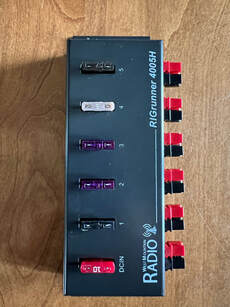 Genuine RiG Runners Last February I reviewed my Pegasus Power Box Advanced (PPBA) power distribution and USB hub which I have been using for more than two years www.californiaskys.com/blog/archives/02-2022. While I like the PPBA and will continue using it, there are cheaper and simpler options available for those who only want a simple device. I am speaking of the RigRunner which is widely used in the Ham Radio hobby as a power hub. The RigRunner is made right here in the USA by West Mountain Radio in Waukesha, WI. www.westmountainradio.com/rigrunner.php. They make 10 different power distribution hub models with prices ranging from $75 to $180 which is much less than the cost of the cheapest Pegasus Power Box. While the PPBA has a lot of features including the ability to turn power ports On/Off, an environmental sensor which can automatically turn on and adjust the power level of my dew heater, an internal meter which records voltage, current and power and a software application which allows one to see all of this and control it from a computer, I seldom use any of these features on mine. If you are like me and, if you already have or do not need a USB hub, one of the RigRunner power hubs may be a better choice for you. 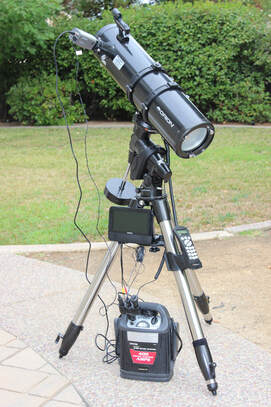 igRunners are made of 0.062 gauge aluminum case with a powder coating paint and silk screened labels. A simple circuit board made with 3oz copper, double sided plated through holes and a solder mask over bare copper wire is inside. Models are available with 4, 5, 6, 7, 8, 10 and 12 outlets to power a variety of devices. Each output comes individually fused. The user has the option to easily change the fuse value since simple ATC/ATO automotive fuses are used and fuses are accessible from the front panel. The DC input is also fused and is user adjustable. Genuine Anderson Power Pole connectors are used for both the power input and outputs. Power Poles allow for secure connections and prevent connecting a device with reversed polarity. Models are available with the outputs configured horizontal to the base of the RigRunner or vertical to meet different user installations. All models are 1.4" in height by 3.0" in depth while the length varies from 4.7" for the 4 outlet model up to 11.75" for the 12 outlet models. Models are rated at 40A total current, except the 8012 model which is rated at 80A. Any output can provide up to the maximum current as well, but the total cannot exceed 40A, or 80A for model 8012. 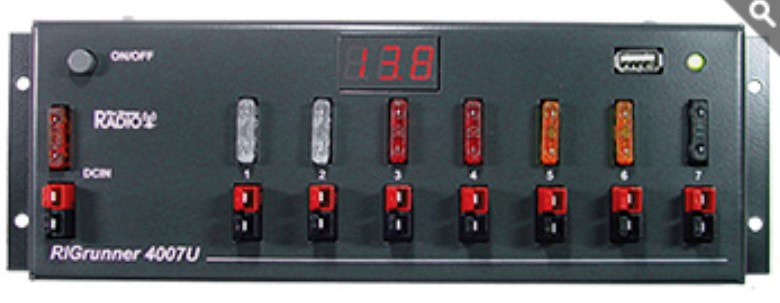 In addition to different numbers of outputs, 3 models include 1 or 2 USB charging ports with a maximum of 2A per port. The 4007U model includes several additional features such as:
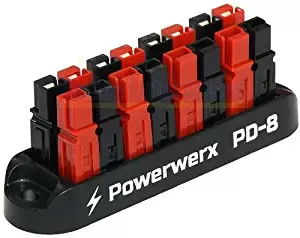 Other Power Distribution Hubs Powerwerx sells 4 position and an 8 position simple power distribution hubs where any one position is used for the input. These are made of sturdy ABS plastic with a sealed internal copper bus bar and are rated to 45A total current for all positions total or any single position. They are also made in the USA and also use genuine Anderson Power Pole connectors. The 4 position hub sells for $37 while the 8 position sells for $50. Both hubs are 1.3" high by 0.97" deep. The 4 position model is 2.33" wide while the 8 position model is 3.75" wide. There are a number of Chinese companies that sell power hubs which appear to be clones of the RigRunner. Examples are the HCDC 8 output model which sells for $72 and the Chunzehui 8 output model for $75. Designs and features appear to be near clones of the RigRunners but they do not use genuine Anderson Power Poles. Instead they use Power Poles which are also Chinese clones of the original. That being said, these appear to be well made and have mostly good reviews.
Summary In summary, if you do not need a combined power and USB hub, and just want simplicity of design and use, something like the RigRunner should be a good option for you. Amazon links are affiliate links which can earn a small commission at no cost to you. Using these helps to support this web site. 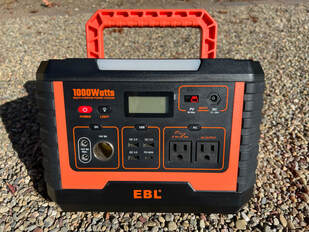 After posting reviews of the Jackery 1000 and the Bluetti AC50S power stations I thought I was done with the world of all-in-one power solutions for the field. But, this past summer I was contacted by EBL and asked if I would be willing to review one of their portable power stations, the Voyager 1000. I must admit that I had never heard of EBL so I did some homework and found that they have been around since the 90's as a supplier of all kinds of batteries (AA, AAA, C, D, 9V, alkaline, Ni-Cd, Li, etc.) as well as battery chargers. Apparently they decided to participate in the recent trend in the market and have come out with four different capacity portable power stations of their own that I think are worth considering. In addition to the 1000Wh model that I tested they also have a 500Wh model ($470), a 500Wh model ($419), a 300Wh model ($179) and two newly introduced larger capacity models using LiFePO4 cells, the 1843Wh model ($899) and the 2097Wh model ($999). These are some of the lowest cost portable power stations from a well known battery manufacturer. EBL also has 100W and 200W solar panels to charge the power stations away from home. A quick check over the specs and features of their Voyager power station had me intrigued, but the phenomenal price, ($470) is what made me decide to accept their offer and conduct my own review. More on that later. I received their Voyager 1000 power station along with two 100W solar panels near the end of July. I followed the same procedure as I have for all my other reviews of batteries and power stations which is to first conduct bench tests to verify the capacity and re-charge times followed by several months of testing in my home observatory and finishing with a field test at a star party. So let's begin. 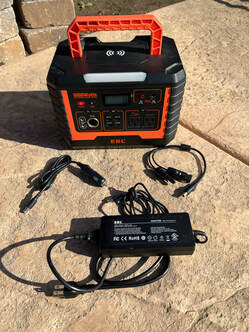 Basic Features of the EBL Voyager 1000 The first thing I noticed is the solid construction of the power station. The Voyager is made of ABS plastic and has rubber bumpers on all four corners to protect it from damage from the inevitable occasional collision with an obstruction when loading and unloading for travel. For additional cushioning It also has four rubber feet on its bottom along with the complete list of product specs. With dimensions of 15.67" x 10.31" x 10.79" and a convenient sturdy handle the Voyager packs a lot of energy at 1000Wh into a small and highly portable package. I very much like the fact that the handle folds down flat unlike another major supplier of power stations so that you can stack other things on top when packing for a trip. All of the controls and ports are located on the front of the Voyager for ease of use. At just 18.7lbs the Voyager is almost 7lbs lighter than its competitor, the Jackery 1000. The Voyager 1000 is rated to supply 999Wh of power in any combination of DC, AC and USB power. As is common with portable power stations, it has a standard cigarette lighter socket for DC connections, but it also has two 5.5mm x 2.1mm DC ports as well. All are rated at 8A each (8A max all three combined) and 12V. The 5.5mm x 2.1mm ports are very convenient for us amateur astronomers since this is the industry standard electrical connection on most astronomy equipment. I had no trouble with my cigarette plug coming loose from the cigarette lighter socket during months of testing, but it is nice to have the option of the other DC power ports. For AC power a pure sine wave inverter capable of 1000W steady state (2000W Max) is built in with two AC ports. This is convenient if one needs to use AC power for their laptop or prefers to power their mount with an AC adapter. My wife used this to power her laptop on a recent boondocking trip in our RV. There are plenty of USB ports to re-charge phones, tablets and even laptops. The Voyager has 3X 3.0 Quick Charge USB A ports capable of 18W of power and a Power Delivery (PD) port with 60W of output. I used these to recharge my phone during my 4 days of field testing. And, there is a 10W wireless charger on the top of the power station. As is typical the EBL power station has an MPPT solar charge controller built in to accept power from one or more solar panels. I like the fact that this one has both an 8mm input and a Power Pole input to provide extra capability for different connectors you might find on solar panels and AC chargers. The Voyager comes with a 150W AC charger and a car adapter cable to charge the unit from the car's cigarette power port. The maximum charging power input is 150W so that two 100W solar panels is probably the maximum you would want to use since any power beyond 150W will not be used by the Voyager. Pass through charging is a nice feature common to most power stations which means that you can use any of the power ports while the unit is being recharged either with solar or the AC power adapter. You will find a master power button and individual power buttons each for DC, AC and USB power on the front of the unit. There is also a small LCD display which shows the percentage state of charge (SOC) in increments of 1%, along with the instantaneous power being consumed and/or the power being charged. This is helpful to keep track of the time remaining to power your devices. The Voyager also has a flashlight feature on its front which provides a nice bright light as needed, which is not typically something we use at star parties but will be helpful on camping trips. Like all Li power solutions the Voyager has an internal BMS which protects the internal cells from being over discharged, over charged or shorted. The BMS will shut the output down when 100% of the useable capacity has been depleted. EBL uses LiNiMnCoO2 (NMC) cells just like most of the other portable power stations because of its high power to weight ratio. EBL warrants their Voyager for 12 months and, although they do not specify the number of full discharge cycles to expect, this is typically 500 for NMC. Operating temperatures are similar to other power stations with a discharge temperature range of 14 to 113 deg F (-10 to 45 deg C) and a re-charge temperature range of 32 to 104 deg F (0 to 40 deg C). 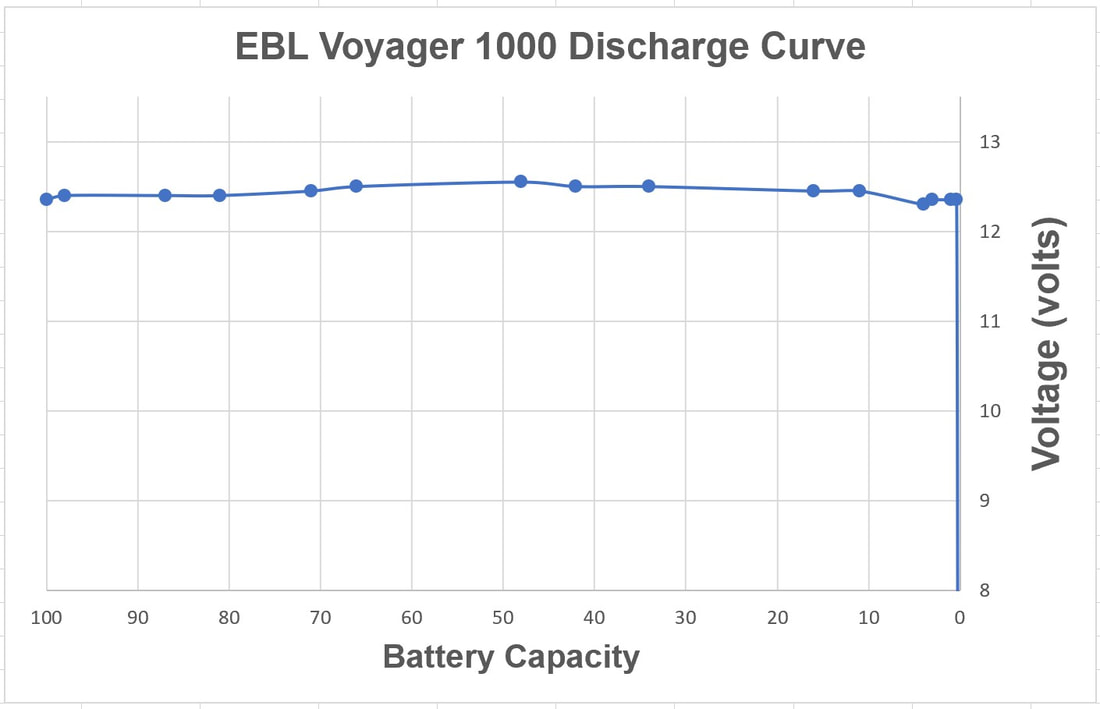 Bench Test Results As with my other power supply reviews the very first test is a bench level test to check the actual capacity versus the manufacturer's spec. Usually these are quite close with the actual power available being within 90% of the spec. with the internal BMS accounting for some of the difference between spec and actual power measured. After charging the Voyager to 100% SOC I attached the DC output to a load tester and set the discharge current to the maximum of 8A. Typical for an NMC power station, the output voltage is regulated. With no load the output voltage was 12.9V. With an 8A load (or a 5A load) the output voltage was maintained at 12.4V for the duration of the test. I repeated this test 3X to check for consistency and found that the average capacity was 912Wh (909, 921, 920, 898) or 73.3Ah (72.9, 73.8, 73.9, 72.7 ). As you can see the repeatability is excellent and the overall capacity is ~92% of the manufacturer's spec which is typical of these solar power stations. For comparison I measured a total capacity of 908Wh for my Jackery 1000 power station. During the discharge test I periodically measure the output voltage to confirm the quality of the voltage regulation and to see at which point the output drops below 12V. You can see from the plot that the voltage is well regulated at 12.45 +/-0.1V all the way until the BMS cut off the output. One thing that I noticed while discharging the Voyager 1000 was that the SOC meter on the unit appeared to read high. Since I recorded the Voyager's SOC meter reading and the Wh and Ah during the discharge tests I could compare the SOC reading to the actual SOC knowing the actual capacity (916.7Wh) determined from the three full discharge tests. What I found is that the SOC meter tracks to the manufacturer's specification of 999Wh within 5% or less. However, since the actual capacity was 917Wh, the meter is reading ~10% higher than the actual remaining power between meter readings of 60% and 10% SOC. For comparison, the SOC reading on my Jackery 1000 was within 3% of the actual SOC all the way to cutoff. Another bench level test is to verify the maximum current that each of the DC output ports can support. In this case the manufacturer specs 8A max but I was able to push the output to 10A without any apparent issues. I do not suggest that you run your Voyager above the spec of 8A as I only do this test to ensure it will work at 8A without any problem. Once fully discharged the next bench test was to re-charge the unit with the included AC adapter. Like the discharge test, this one was conducted 3X and the result was a very repeatable 7.7hrs (7.7, 7.7, 7.55) to go from 0% SOC to 100% SOC. One interesting thing to note during the re-charge cycle is the fact that the SOC meter on the front panel indicated 99% SOC at 6.5hrs but it still took 1.2 hours more to reach 100% SOC. This was very repeatable as well. Curious to know whether this was real, I charged the Voyager until the meter just reached 99% and then did a full discharge test. This time, my load tester measured a total of 743Wh which is just 81% of the measured capacity. This means that when the SOC meter just reaches 99% of capacity it still has another 173Wh to go before it is fully charged. The numbers all add up since at ~1.2hrs at 150W will pump an additional 180Wh of energy into the power station to reach a full charge. The moral of the story is, when charging let the BMS shut down the charging input to be certain a full charge is achieved. While for astronomy applications in the field it is always better to use DC power directly rather than to use an AC inverter sometimes we just need AC power. So, I measured the efficiency of the Voyager's AC inverter by using it to power a fan through a full discharge cycle. I measured the AC power output using a KilaWatt meter. After adjusting for the slight power consumption in the meter itself I found that this inverter is ~93% efficient in converting DC to AC which is excellent. Solar Recharging When we are out in the field we do not usually have AC power available and have to rely on solar panels to recharge our power supply. As I mentioned in the introduction, EBL also supplied 2 of their 100W Apollo solar panels which I used to recharge the Voyager. The dual charging inputs (8mm & Power Pole) makes it easy to use solar panels from any number of other vendors if you want. With full sun in late summer I was able to fully recharge the Voyager in 9.5hrs which is longer than the 7hrs indicated on the EBL website. This would indicate that I was not getting the full 150W of charging input power that I was getting from the AC charger. Unlike AC charging, solar charging depends upon the amount of sunshine, angle of the sun relative to the panel and the temperature of the panel so one can expect a wide range of recharge times under different conditions and times of the year. I fully expect that this time would come down if I had run the test during the summer when the sun was higher in the sky. Backyard Observatory Testing Before taking the Voyager into the field I used it over a period of 3 months to power my equipment in my home observatory. This provides an opportunity to get used to its controls and operation and to find out if there are any glitches or incompatibility issues with my equipment. At home I have a Celestron C11 Edge mounted on a Software Bisque MX mount. I use a DC-DC voltage converter to boost the voltage from 12V to the 48V that the MX requires. For astro-imaging I use a ZWO ASI1600MC uncooled camera and a ZWO ASI224MC camera for guiding. When needed I use a dew strap to keep dew from forming on the corrector plate. I use a Celestron motorized focuser and a pair of fans from Deep Space products to help cool down the optical tube in the early evening. A Beelink Mini-PC runs all of the astronomy software to control all of the equipment and imaging runs. I can connect to the Beelink wirelessly via a GL.iNET wireless router with a separate laptop from which I can control everything and keep track of progress. Power is distributed to all of the equipment at the scope, but not the laptop, through a Pegasus Power Box Advanced power and USB hub. Power is supplied to the Pegasus from the Voyager using its cigarette port. Total power consumption varies from ~30 to ~50W. I had no issues running this way for the 3 month duration of the testing. 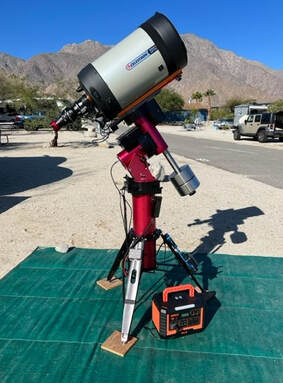 Field Testing The field test is my favorite part of the review which is where I get to take the unit out to a dark site during a star party to see how it performs in real world conditions. In this case I took the EBL Voyager with me to the Nightfall star party in Borrego Springs, CA. The Voyager supplied all of the power for my setup which consisted of the same equipment as at home, except that my Celestron C11 was mounted on a Software Bisque MyT mount instead of the MX. Because of the desert climate I had no need for the dew heater. In total, my power load, excluding the laptop which was powered separately, was ~38W. Over 3 nights I powered all of this without recharging the Voyager for a total of 20.6hrs with enough power remaining that I could have powered this setup for a total of ~24hrs before needing to recharge. Now, everyone has a different setup so how long can you expect the EBL to power your particular rig? I have put together a chart which breaks down typical setups and an estimate of the accompanying power consumptions into three groups. A low power setup would consume 30W or less and would include pretty much any scope and mount combination along with a Raspberry Pi, Mini-PC or Intel Nuc to run all of the software and hardware. It would also include an uncooled camera along with a guide camera, a motorized focuser, cooling fans and maybe even a filter wheel. It might also include a power distribution hub, powered USB hub or combination like my Pegasus Power Box. With a setup like this one could expect the Voyager to supply enough energy to run for at least ~30hrs. That could be enough for 2 or even 3 full nights without the need to recharge the Voyager. For those who use a cooled camera and possibly a dew heater, the power consumption can rise to as much as 60W. In this case, the total run time would be cut in half but still allow for a full night or 2 short nights of imaging. For those who run their equipment with a 15.4" laptop instead of a lower power consuming mini-pc, etc., the power required jumps to between 90 and 120W depending upon the particular laptop model, how long the monitor is kept on and what other power conservation approaches are taken. In the extreme case of 120W, one might expect to have enough energy to run for ~7hrs before needing to re-charge. EBL Voyager 1000 Summary Overall I was very happy with the performance of the Voyager 1000 during my 3.5 months of testing. The Voyager performed as expected providing consistent steady power for all of my equipment right down to BMS shutoff at 0% SOC. For $499.99 including a $380 coupon on Amazon the Voyager is nearly half the cost per watt-hour as many of the other power solutions on the market. That's just $0.50 per Wh of energy. Between its performance and cost this all-in-one power station should provide stiff competition in this market. I will reiterate that from the outside the Voyager is well designed and well put together. I will leave it to other reviewers to do a tear down review so that we can see if it is equally well made on the inside. What I like: 1. Price. With the current coupon on Amazon the Voyager 1000 sells for $499.99. That's $0.50 per Watt-hour compared to $0.95 per Watt-hour for the Jackery 1000. 2. Two 5.5mm x 2.1mm DC power ports consistent with the standard power ports on most astronomy equipment. 3. Compact, light weight design with rubberized bumpers on all four corners. 4. Sturdy folding handle which allows for better stacking for a trip. 5. QC 18W USB power ports for faster charging. 6. All ports and controls on the front for easy access. 7. MC4 to 8mm charging cable included. What I dislike: 1. 1 year warranty compared to 2 years for its competitors. 2. DC output is limited to 8A compared to 10A for its competitors. However, for typical astronomy applications, 8A or ~100W is more than sufficient. 3. EBL should specify the number of full discharge cycles expected. 4. EBL needs to fix the SOC meter so that it more accurately reflects the SOC both during discharge and charge cycles. Amazon links are Affiliate links from which I can earn commissions at no cost to you. If you would like to support my web site and its content please consider using my links when ordering products.
The EBL Voyager 2097Wh, 1843Wh,1000, 500 and 300 Power Stations along with their Apollo 100W and 200W solar panels can be ordered from the Amazon links below. These are some of the lowest priced portable power stations on the market. EBL 2097Wh Model with LiFePO4 cells amzn.to/426PnA3 EBL 1843Wh Model with LiFePO4 cells amzn.to/482rwD2 EBL 1000 amzn.to/47A5vuZ EBL 500 amzn.to/422l1i6 EBL 300 amzn.to/3Sq27Pi EBL 100W Portable Solar Panel amzn.to/3U3IFc0 EBL 200W Portable Solar Panel amzn.to/3u6FEgu You may also want to watch the video review of the EBL Voyager 1000 which I posted on my YouTube channel which can be found here www.youtube.com/watch?v=7ZldEI-GMHU 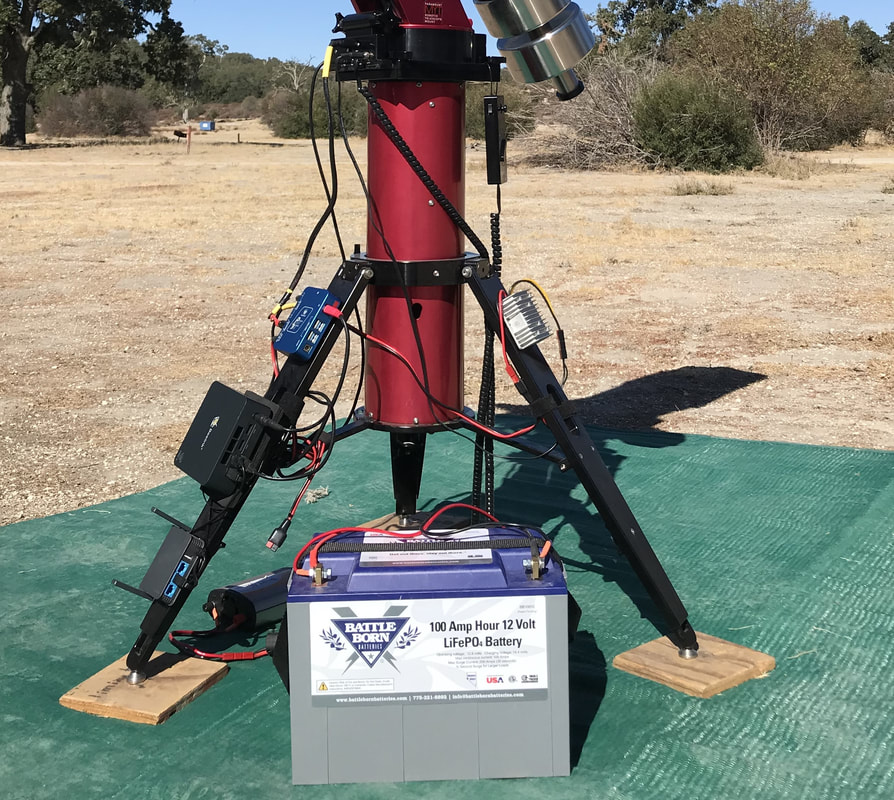 Mini-pcs are becoming increasingly popular for both Electronically Assisted Astronomy (EAA) and astrophotography. This is because a mini-pc allows one to connect remotely to the telescope, mount, camera, and other equipment with a laptop, tablet or phone without being tethered by a USB cable. Remote may mean inside one's house while the telescope is out in the back yard or inside a small tent or EzUp where you can stay comfortably warm and away from annoying bugs when observing away from home. It may even mean sitting in your own house with your telescope set up at a distant remote observatory. In my case, it means being inside my house when observing at home with my equipment setup in the backyard observatory or inside my RV when at a star party or other remote site. Being untethered allows me to move freely from inside (house or RV) to the side of the telescope whenever I need to be close but then being able to return to the inside for most of the night. Utilizing a mini-pc at the telescope will also reduce the power required to keep everything running through the night. A mini-pc uses much less power than a typical laptop. If you connect remotely to the mini-pc with a laptop you can still save power since you do not have to have the laptop on all the time since it is only being used as a monitor to check in on the mini-pc from time to time. In fact, you can simply turn off the laptop once the mini-pc is up and running and leave it off until you are ready to shut down the session. A tablet or phone can be used instead of the laptop to remote into the mini-pc which gives more options in terms of saving power since these use much less power than a laptop. What is a Mini-PC? A mini-pc is a headless computer which comes in a small form factor typically 5" - 6" on a side by about 2" - 3" thick or even smaller. Headless means that it comes without a monitor, keyboard or mouse. This cuts down on the size, cost and power consumption, all important for astronomy applications. Since a mini-pc is a computer it will have a CPU, RAM, non-volatile memory, a GPU, USB and HDMI ports, a LAN port, WiFi, and Bluetooth capability. It will also come with an installed operating system such as Windows 10 or 11. The mini-pc can do anything a laptop can while running the applications needed for complete control of mounts, cameras, focusers, dew heaters, etc. This includes running image capture software, guiding software, planetary software, plate solvers, planning software and imaging session automation and control software like NINA or SGP. For instance, on my mini-pc I have The Sky X for mount/camera/focuser control and image capture, Sharpcap for EAA, Ph.D2 for guiding, All Sky Plate Solver and ASTAP for plate solving, Cartes du Ciel as my planetary software, and Sky Tools 3 Pro for planning. I recently added NINA which will take responsibility for overall control and sequencing of my astro-imaging sessions which still uses TSX, Ph.D and ASTAP. In general, a mini-pc is not expected to do the heavy lifting of post processing the photos captured during an astrophotography session, although it is expected to handle the live image stacking, dark frame subtraction and stretching typical in an EAA session. Usually, the burden of post processing astro images is tasked to a separate, more powerful and more expensive laptop or desktop computer. But, there is no reason it cannot be done on the mini-pc if configured to do so which requires a keyboard, mouse and monitor. Even when post processing is left to a separate computer, it is imperative to have a keyboard, mouse and monitor to attach to the mini-pc for initial setup and for analysis in case something goes wrong. In two years I have only had to pull out these once in the field and it turned out that the problem was operator error, not something wrong with the mini-pc or my WiFi router. Still, having these as backup is essential in the rare case that something goes wrong. 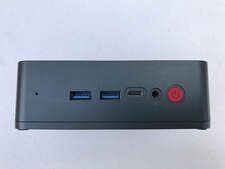 My Beelink U57 with 5th Gen Core i5, 8GB RAM and 256GB SSD My Beelink U57 with 5th Gen Core i5, 8GB RAM and 256GB SSD Choosing a Mini-PC When it comes to mini-pcs there are a seemingly endless number of options available which constantly change as new hardware components become available. New mini-PCs can be found for under $200 on models with Celeron and Core i3 processers to over $1000 for models with high end processers, GPUs and lots of memory. Keep in mind that even with the same models, prices fluctuate frequently both up and down. The correct choice depends upon one's particular application, future plans and pocketbook. Typically, the trade off in performance and price leads to mini-pcs used for astronomy costing somewhere between $200 to $500. Beelink is probably one of the most popular mini-pc manufacturers in this price range. Recently, inexpensive models from Mele Quieter have gotten a lot of notice on the Cloudy Nights forum as well. Intel NUCs (Next Unit of Computing), designed and built by Intel, are also quite popular and include some of the high end mini-pcs as these NUCs come in many configurations including kits which can be customized to the users requirements. 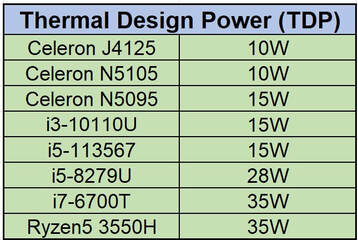 When choosing a mini-pc the first feature to consider is the CPU. At this point in time mini-pcs used for astronomy usually include a Celeron or Core i3 processer for the less expensive models or an i5 processer for the slightly more expensive models. Many people report success in astrophotography and even EAA with mini-pcs using Celeron processors. However, for high data rate applications as is the case with larger format cameras (20Mpixels or larger) or live stacking of very short exposures (less than 5 sec subs) with dark frame subtraction and flat frame calibration for EAA, the Celeron class of processor may not be up to the more challenging tasks. In these situations an i5 processor would be a safer choice while the added cost of an i7 processer might be better applied to more RAM or a larger and faster SSD. For planetary imaging requiring extremely high image capture rates one should consider at least an i5 and possibly an i7 processor with fast SSD storage. Celeron processors found in these mini-pcs include the Gemini Lake J4125 and the Jasper Lake N5095. For Core i5 processers the Tiger Lake 113567 and Coffee Lake 8279U are typical. In addition to processing speed and cost another attribute of CPUs to be considered is the Thermal Design Power (TDP) which is indicative of the maximum power that the CPU can generate. The higher the TDP the more power one needs in the field to keep the mini-pc running all night long. One of the desirable features of the mini-pc is its lower total power consumption compared to a laptop. The accompanying table shows the tradeoff in CPU capability and TDP. After the CPU the amount and type of RAM and mass storage is probably the next most important consideration. 8GB of RAM is sufficient for most situations and is fairly common in pre-configured mini-pcs, while 16GB can help when many applications are open at the same time. As far as mass storage one should consider 128GB to be the minimum choice in which case you may have to constantly download image files to another storage device after an imaging session. I opted for 256GB which allows much more margin, but even then I sometimes wish that I had paid the extra for 512GB. The choice will depend on your imaging/EAA habit and how often you are willing to transfer images from your mini-pc to your processing pc. Mass storage on the mini-pcs often used for astronomy typically have one of three types of mass storage including M.2 SATA SSDs, M.2 NVE SSDs or eMMC. The first two can be replaced while eMMC is soldered onto the motherboard and cannot be replaced. NVE SSDs use the PCIe interface which is much faster than the SATA interface used by SATA or eMMC devices. All will work but the M.2 NVE SSD is the better choice for high data rate applications. Probably the next most important consideration in choosing a mini-pc is the number and type of USB ports because of the need to connect our many astro devices to the mini-pc. Most mini-pcs in the price range being discussed usually provide at least 4 USB ports in some combination of USB2.0 and USB3.0. Some also provide a USB Type C port with even faster data transfer rates. Don't forget to reserve one USB port for a WiFi dongle when using a wireless keypad and mouse. On other hand, if like me, you have a USB hub like the Pegasus Power Box which you use to connect your astro devices, you will only need to connect the hub to the mini-pc, preferably over a USB 3.2 port for fastest transfer rates. Another choice is whether or not to choose a mini-pc with a fan or not. Fans consume additional power. And they can, in principle, cause vibrations although I have never witnessed any such problem with my mini-pc attached to the leg of my tripod. On the other hand, fans will keep the CPU cool so that it can operate at its highest speed whereas air cooled mini-pcs can get hot causing the CPU to throttle back. Beelink tends to incorporate fans into their models while MeLE Quieter does not. Many folks agonize unnecessarily over the fact that some mini-pcs require 19V power input instead of 12V. This is easily rectified with an inexpensive DC-DC boost converter which takes a 12V input and provides a steady state 19V output. The boost converters are ~95% efficient while the AC transformer typically supplied with any mini-pc is likely ~80% efficient. I find the easiest way to incorporate these into my setup is to attach Anderson Power Poles to the leads and use Anderson Power Pole to 5.5 x 2.1mm adapter cables to connect to my equipment. All mini-pcs include an ethernet port for wired connection, WiFi and BT capability, along with one or more HDMI ports. You will need one HDMI port to connect a monitor initially to set up the mini-pc and any time something goes wrong with your connection to the mini-pc and you need to trouble shoot the situation. Mini-pcs come with Window 10 or Windows 11 software already installed. Look for the Pro version which is required for some remote connection software like Team Viewer and Remote Desktop. 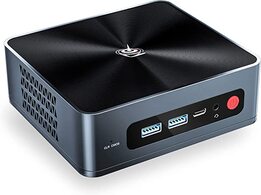 Beelink SEI8 Beelink SEI8 Mini-PC Models to Consider Below are a number of different mini-pc models currently available. Prices will vary and over time models will change, but this can be a good starting point. Beelink has a large following in the astronomy community judging from posts on CN and is the brand I have used and been happy with for the past 2 years. You can search through all their models on the Beelink Amazon store. A few examples are worth considering. The Beelink U59 Pro comes with a Celeron N5105 processor, 8GB of RAM, a 500GB M.2 SATA SSD, 4 x USB 3.0 and 1 x USB C ports, 2 LAN ports, 2 x HDMI ports, WiFi, BT, and Windows 11 Pro. It has a cooling fan and operates on 12V and is currently on sale for $219. You can add 8GB more RAM for another $25. The Beelink SEi8 has an i5-8279U processor, 16GB of RAM, a 500GB M.2 NVME SSD, 4 x USB 3.0 and 1 x USB C ports, 1 LAN port, 2 x HDMI ports, WiFi, BT and Windows 11 Pro. It also has a cooling fan and operates on 19V and also has an auto startup feature so that you can set it to automatically turn on at a set time each day. This model is currently on sale for $397. Compared to the model above you get a faster processor, twice the RAM and a faster SSD. 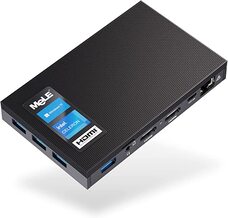 MeLE Quieter 2Q MeLE Quieter 2Q If you are looking for a fanless mini-pcs, the models from MeLE Quieter are becoming popular among amateur astronomers lately. Here are two worth considering. The MeLE Quieter 2Q uses the Celeron J4125 processor, 8GB of RAM, 128GB of eMMC storage, a Micro SD card slot of storage expansion, 4 x USB 3.0 ports, 1 LAN port, 2 x HDMI ports, WiFi, BT and Windows 11 Pro. It does not have a cooling fan and can also be configured for auto startup. This model is currently on sale now for $210. Like most mini-pcs there are upgraded versions of this model with up to 512GB of eMMC storage for an additional $90. The MeLE PCG35 has a Celeron N5105 CPU, 8GB of RAM, a 256GB NVMe M.2 SSD, a Micro SD card slot of storage expansion, 2 x USB 2.0 and 2 x USB 3.0 ports, 1 LAN port, 2 x HDMI ports, WiFi, BT and Windows 11 Pro. It does not have a cooling fan and can also be configured for auto startup. This model is currently available for $310. Both of these MeLE models require 12V input power. Intel NUCs can be found at the Intel Store for as little as $200 to well over $1000. An example is the Intel NUC 10i3FNHN which currently lists for $499 and includes an i3-10110U processor, 8GB of RAM, an 512GB of PCIe SSD, 3 x USB 3.2 ports, 1 Thunderbolt (Type C) port, 1 HDMI port, 1 LAN port, BT, WiFi, an SD card slot and Windows 10Pro. It requires 19V for power. 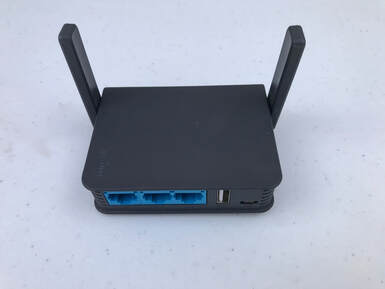 GL.iNet Slate Portable Router GL.iNet Slate Portable Router Mini-PC Operation Being small and light, a mini-pc can be mounted on top of the telescope which minimizes the length of cable runs between cameras, focusers, dew heaters, filter wheels, the mount and the pc. Often the mini-pc can be found mounted to the leg of the tripod or at the base of the mount. If the mini-pc has a cooling fan, this may be the best place to mount it to minimize the chance of vibrations in the optical system. This is my typical configuration since I have a Software Bisque Mount with through the mount cabling. In addition to the mini-pc some method to connect between a laptop/tablet/phone and the mini-pc is required. This involves a remote desktop application like Team Viewer, VNC Connect, Remote Desktop or one of the many others which are free and easy to use. These generally require that the mini-pc has the Pro version of Windows to work. The second requirement for remote connection is the ability to make a WiFi connection. At home this could simply be your home internet network assuming that you have a LAN line to connect to the mini-pc in the back yard. I use a Cat5 cable I strung out to my backyard observatory 10 years ago to connect from my laptop anywhere inside the house to my mini-pc outside on my home network. In the field or at home if you don't have a wired connection in the back yard, you will need to create your own WiFi network. This is simple to do with an inexpensive portable router. I have reviewed 2 such inexpensive routers from GL.iNet in an earlier blog which you can find here. A video version of my review can also be found here. I have been using the GL.iNet 750S Ext (Slate) for 2 years and could not be happier. I can stay connected from inside my RV to my telescope up to 100 feet away. At home I can use the Slate as a repeater and connect to my home internet without the need for a LAN cable connection. GL.iNet has another model capable of higher data rates called the Beryl for just a few dollars more which is worth considering. If you need help setting one of these up, I created a video showing how to do this step by step. Summary Having used my mini-pc for two years both at home and at many star parties I have been extremely happy that I finally made the move to untether myself. With one exception (operator error) I have not lost any time due to problems connecting or using the mini-pc. And, I have not noticed any problems when using it for astrophotography or EAA. Hopefully I have given you a helpful overview of the considerations required to set up your own remote connection so that you can make the right choice for your situation. The one possible downside of using a mini-pc is that it tends to keep me inside, even at star parties, instead of out under the night sky. I have had to remind myself that one of the great things about being at a star party is to be able to look up and appreciate the wonder of the Milky Way with my naked eyes. So, I make it a point to spend some time outside both viewing the night sky and talking with my fellow amateur astronomers instead of spending the entire night away from the action inside the RV. You can find a complementary video tutorial on this subject on my YouTube channel which you can find here www.youtube.com/watch?v=TRk2wsrOnNM Beelink Mini PCs amzn.to/48Vp3Lm
MeLe Quieter Mini PCs amzn.to/47KLXUK Intel NUCs amzn.to/47KM1ns GLi.Net Portable Routers amzn.to/4b1oamt Links are Amazon Affiliate links from which I can earn commissions at no cost to you. If you would like to support my web site and its content please consider using my links when ordering products. 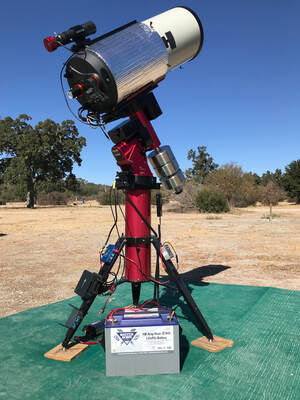 Two years ago I decided that I was no longer willing to have my laptop tethered to my telescope with a long USB cable. When I am in the field I normally site inside my EZUp tent with my laptop to stay warm and to limit the light infringement on my neighbors. While this has worked well for many years, the cable presents a tripping hazard especially at star parties where other folks tend to stop by. And now that I have an RV I want to sit inside and not worry about running a USB cable through an open window or door. So, I looked into what is needed to go wireless and found that it was not at all difficult. First, we need computing power at the mount to run all of the software used to control the mount, camera, focuser, guider, dew heaters, etc. Second, some sort of WiFi either built into the computer or through a small travel router is required to link the computer at the mount to the device inside. Third, software designed to allow a laptop, tablet or phone to be connected to and control the computer at the mount is also needed. Let's look at each of these in detail. Off the Shelf Solutions There are a number of different ready made solutions available from the astronomy industry. On the high end there is TheSky Fusion (available from High Point Scientific) from Software Bisque. At the heart of the Fusion is a 64bit Hex-Core CPU with 4GB of RAM which drives TheSky imaging addition software which is included with the Fusion. A total of 190GB of on board memory is available to store images. It has an integrated WiFi with an external antenna to provide wireless connection to a pc, laptop, tablet or phone. It also comes with an ethernet port in case of the need for a hard wire connection and it has internal GPS. TheSky Fusion integrates USB hub capability with 4 USB3.0 ports and can operate as a power distribution hub with 8 configurable power ports capable of supplying up to 40A using Anderson Power Pole connectors for reliable connections. At 4.2lbs the Fusion is designed to be mounted on top of the telescope to allow for simpler cable management. With a price of $1895 TheSky Fusion is on the high end of off the shelf WiFi solutions but it is certainly packed with useful features combining the functions of a computer, WiFi, USB hub and power distribution all in one. Another high end solution comes from Prima Luce Labs in their line of four different telescope control units ranging in price from $795 to $2195. The least expensive model is the Eagle LE (available from High Point Scientific) while the most expensive model is the Eagle 4 Pro (available from High Point Scientific) The LE has an Intel Celeron Dual Core CPU with 4GB of RAM and 120GB SS memory while the Pro has a Quad Core I5 CPU with 16GB of RAM and 480GB of SS memory. Both provide connectivity via WiFi with an external antenna and through an ethernet port. Both models have ample USB ports and 7 power ports, 3 of which allow voltages to be configured from 0V up to 12V. The Pro model includes a GPS. Any software can be installed onto these units just like a normal pc and, like the Fusion, these units are designed to be installed on top of a telescope. The Eagles use proprietary connectors on the 4 12V non-configurable power ports so one has to add the cost of these cables to the total cost of the unit. Like TheSky Fusion Prima Luce Labs' models combine multiple capabilities into one device. ZWO's ASIAIR Plus (available from High Point Scientific)is a much less expensive WiFi solution but with less computing power and fewer bells and whistles. At the heart of the Plus is a Raspberry PI 4 processor with 32GB of internal storage and a slot for a MicroSD card. It has an external WiFi antenna and an ethernet port. Unlike the models from SB and Prima Luce Labs, the ASIAIR will only work with ZWO cameras, focusers and filter wheels but it will work with a large variety of mounts. Like the SB and PL units it also acts as a USB hub with 4 USB ports and a power distribution hub with 4 12V power ports capable of a total of 5A. The ASIAIR is also designed to be mounted on top of a telescope but has a much smaller footprint than the SB and PL units and weighs less than 0.5lbs. At a price tag of $299 the ASIR Plus is a slimmed down version both in size and capability of the more expensive SB and PL models. The Stellarmate Plus is the least expensive ready made WiFi solution at $229. Like the ASIAIR it uses a Raspberry PI 4 processor, has 2GB of RAM and includes a 32GB MicroSD card for storage. In addition to the WiFi the Stellarmate also has an ethernet port but no external WiFi antenna. It has 4 USB ports but no external power ports. Like the ASIAIR the Stellarmate is compact and light weight. Unlike the ASIAIR, Stellarmate works with a wide variety of astronomy equipment. It includes a copy of EKOS Astrophotography software and is compatible with a variety of other software applications. 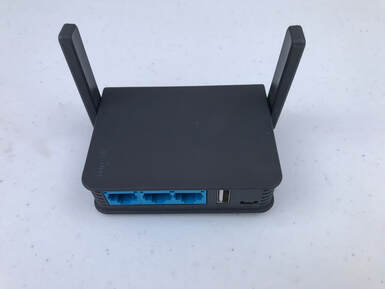 GL.iNet AR750S Portable WiFi Router GL.iNet AR750S Portable WiFi Router Build Your Own Solution While the above ready made wireless solutions will work, each has its cons. The high end models are expensive and better CPUs, and more RAM and memory can be found for less money. The lower cost models only come with a Raspberry PI processor, which works, but is limited in ultimate capability and they have very little RAM and memory. With just a little bit of effort, and not much more cost, if at all, compared to the ASIAIR and Stellarmate options, one can put together a better custom tailored solution on their own. I chose to build my own solution with the features and capabilities that I wanted. A custom WiFi solution requires three components. The first is a CPU at the mount to run all of the software used to control the mount, camera, focuser, guider, dew heaters, etc. This could be an inexpensive laptop, a headless Intel NUC or mini-pc, or a home brew Raspberry PI. I decided that the best solution for me was a headless mini-pc because it offered the best price to feature ratio. I bought a Beelink U57 mini pc with an Intel Core I5 processer, 8GB RAM and a 256GB solid state drive for under $360. And considering that I use a Pegasus Power Box Advanced which cost $330 I have all of the features that TheSky Fusion offers that I need for less than half the price. The mini pc comes with Windows 10 Pro installed so that I can run any of the typical software that I use such as The SkyX for mount/camera/focuser/guider control and image capture. I can also use SharpCap if I want to do electronically assisted astronomy (EAA), PhD for guiding, Nina or Sequence Generator Pro for image sequencing, etc. I am also not constrained to work with any one manufacturer's equipment as a mini pc works with any mount, camera and accessory that is ASCOM compatible. While my model is no longer available, you can find something similar for just $249 or choose from a wide variety of mini-pcs from Beelink with different processors, RAM, memory, USB ports, etc. While my mini-pc uses 12V, most mini-pcs or Intel NUCs require 19V which can easily be supplied using a 12V battery and a 12V to 19V DC-DC voltage converter like this one. The second component is WiFi. I found two inexpensive portable wireless routers from GL.iNet that I bought and tested, the GL-MT300N (Mango) and the GL-AR750S (Slate) models. The 750S provided greater range due to its pair of fold up antennas and also offered 5GHz capability which helps to mitigate potential interference on the 2.4GHz band from nearby equipment. I am able to set up inside my RV up to 100 feet away from the mini-pc and maintain a good connection all night long with the Slate. I can also set up just inside my house and stay connected to the mini-pc inside my backyard observatory when at home. You can read my review of the Slate and its smaller Mango alternative in my Feb '21 Blog or view my video review of these two on YouTube. There is a newer model with fold up antennas, the GL-MT1300 (Beryl), which offers twice the data rate of the Slate. The last component to make this all work is a way to make the remote connection from the laptop (or tablet or phone) to the mini-pc to use the laptop as a terminal to view and control the software on the mini-pc. There are many free remote connection options and I tried two of them, Remote Desktop and Team Viewer. I chose Team Viewer but any of the many options will work fine. The choice seems to come down to personal preference. Also, you will most likely need to have the Pro Version of Windows software installed in order to use the remote connection software, but most of the mini-pcs seem to come with that. 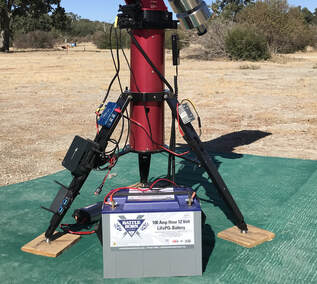 Router - Mini PC - PPBA On Tripod Leg Router - Mini PC - PPBA On Tripod Leg Set Up & Operation I choose to have my mini-pc attached to the leg of my telescope tripod since my SB MyT mount can supply all the power I need to the cameras and focuser through the mount itself. I also have through the mount wiring for the dew heater. For some people this will work, but others may choose to set up the mini-pc or Intel NUC on the telescope itself. These are small enough and light weight enough as to add little inertia to the telescope. The Slate router gets its power from the mini-pc. Power to everything comes from a LiFePO4 battery or Jackery solar generator which is fed through the Pegasus Power Box Advanced. I just power up the PPBA, turn on the mini-pc and the mount and step away to my laptop. It takes a few minutes for the router to set up its WiFi signal which I connect to with my laptop. Once connected to the router I run Team Viewer to connect to the mini-pc and begin my session with The SkyX and any other software that I need which resides on the mini-pc. Images are captured difrectly to the mini-pc and retrieved later for post processing on my laptop. When my session is over, I simply park the mount, turn off the cameras and close The SkyX and any other software (ShapCap, PhD) that I have running on my mini-pc. Then I turn off the mini-pc remotely. I can leave everything like this or I can go over to the telescope and disconnect the battery or turn off the Jackery. Additional Considerations If you go the route of a headless mini-pc or NUC I suggest that you carry with you a mouse, keypad and small LCD display. This way, if something goes wrong you can connect to the mini-pc and see what is going on. You can use a wired mouse and keypad you may already have lying around or you can purchase a wireless set similar to the one I did. You will also need a small LCD display and there are many to choose from. It is also worth knowing that the wireless routers I discussed above can also work as WiFi repeaters at home which is how I use mine. The router can be set up to connect to the home WiFi and then I can use my laptop from anywhere inside my house to connect to the mini-pc out in the observatory. Of course, how well this works depends upon the strength and coverage of your home WiFi signal, but it is a nice additional advantage of the wireless router if you do not already have either WiFi or cable at your backyard observing location. Summary For those who prefer ready made solutions there are several very good options which we discussed to choose from across a broad range of prices and features. However, if you are inclined to set up your own system you can customize it to your specific needs, including only those elements that you need and avoid paying for features you do not want. And, a custom solution will give you the greatest flexibility in terms of equipment and software compatibility. You can find a companion video I made on this topic here www.youtube.com/watch?v=quoWbvN5VWc&t=1220s Some links are Affiliate links where I can earn with purchases at no cost to the buyer which help to support this web site. If you would like to support my web site and its content please consider using my links when ordering products.  LiFePO4 batteries are becoming more and more common for use in powering astronomy equipment either in the field at a dark site where no power is available or in a remote observatory with only solar power. There are many very good LiFePO4 batteries on the market and I have reviewed two of them on this Blog page previously: Battleborn's 100Ah and Bioenno Power's 50Ah batteries. While both of these are very good options, they are on the expensive side, costing ~$8.7 and ~$10.8 per Ah, respectively. So I searched for another option with a much better price point and found Ampere Time's 100Ah LiFePO4 battery which sells for ~$4 to $4.7 per Ah. Ampere Time also makes 200Ah, 300Ah batteries for even less per Ah and a smaller 50Ah for ~$5.8 per Ah. With a cost of half the other two batteries and many excellent on line reviews the Ampere Time battery caught my attention. So I contacted them and they agreed to send one of their 100Ah batteries to me to test. 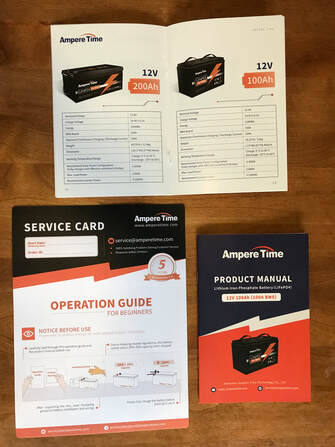 Basic Features The Ampere Time 100Ah battery weighs only 22.25lbs which is nearly 1/3 the total weight of a 100Ah lead acid battery making it much easier to carry back and forth out into the field or even just the back yard, especially with the included strap. The 100Ah battery is 13" long x 6.82" deep x 8.48" tall which is similar in size to any other 100Ah battery. The battery is expected to have a 10 year life and provide 4000 or more full discharge cycles. It also comes with a 5 year warranty and Ampere Time claims they will respond to questions and service requests within 24hrs although I have not verified this myself. The battery includes the best documentation for operation and care of any of the three batteries I have tested. Since this is a Li battery it comes with a Battery Management System (BMS) which is internal to the battery case itself. The BMS works in the background to monitor the individual lithium cells and make sure that the battery is operated in a safe mode at all times. It provides protection from short circuits, over current, over charging and over discharging. The later means that one can safely fully discharge the battery at which point the BMS will shut down the output. While considered "fully discharged" there is still sufficient voltage on the internal cells to avoid damage and maintain the projected useable life of 4000 or more such full discharges. Operating temperatures are -4 deg F to 140 deg F (-20C to 60C ) for discharging and 32 deg F to 122 deg F (0C to 50C) for charging, which is typical of most LiFePO4 batteries on the market. It should be noted that unlike the other LiFePO4 batteries I reviewed, this Ampere Time battery does not have a low temperature sensor to automatically prevent charging or discharging below the lower temperature limit. This means that the BMS cannot protect the internal cells from damage if one attempts to charge the battery below 32 deg F or discharge it below -4 deg F. However, for astronomy applications I think it is very doubtful that we would be in a situation where we would attempt to recharge the battery when the temperature is below 32 deg F and most do not work in temperatures below -4 deg either. While an unlikely scenario, if one has the need to recharge below freezing Ampere Time makes a battery with an internal self heater that allows charging down to -4deg F. 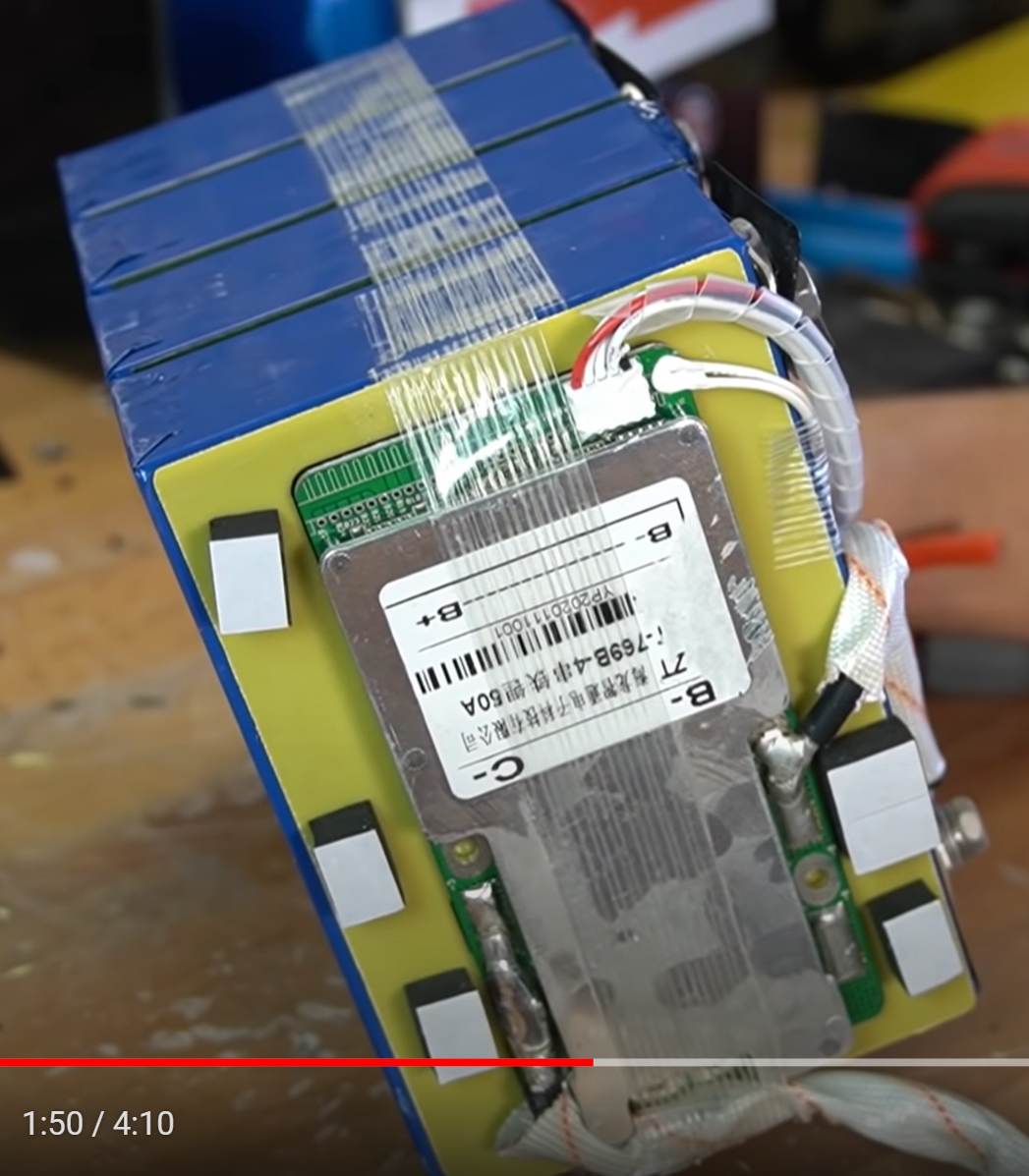 Will Prowse's Ampere Time 50Ah tear down video showing 4 prismatic cells and the BMS Will Prowse's Ampere Time 50Ah tear down video showing 4 prismatic cells and the BMS Inside the Battery Besides the low cost of this battery the other reason I decided to review it was the tear down video on Ampere Time's 50Ah battery by Will Prowse which shows the internal components (Li cells, BMS, Wire Gauge, etc.) and build quality to be quite good. I recommend anyone interested in an Ampere Time battery to take a look at that video. The tear down also shows that Ampere Time uses prismatic cells instead of the cylindrical cells used by Battleborn and Bioenno Power. Because prismatic cells are larger and have greater capacity than cylindrical cells only 4 cells are needed to achieve the 100Ah capacity compared to the 120 cylindrical cells found in the 100Ah Battleborn battery. The four prismatic cells are arranged in series with each cell having a nominal voltage of 3.2V and a capacity of 100Ah. In this configuration a nominal voltage of 12.8V is obtained. While less cells has its obvious advantages, damage to a single cell will result in a drop in the voltage making the battery no longer useable. In contrast, damage to a few cylindrical cells in the Battleborn battery may hardly be noticed by the user. 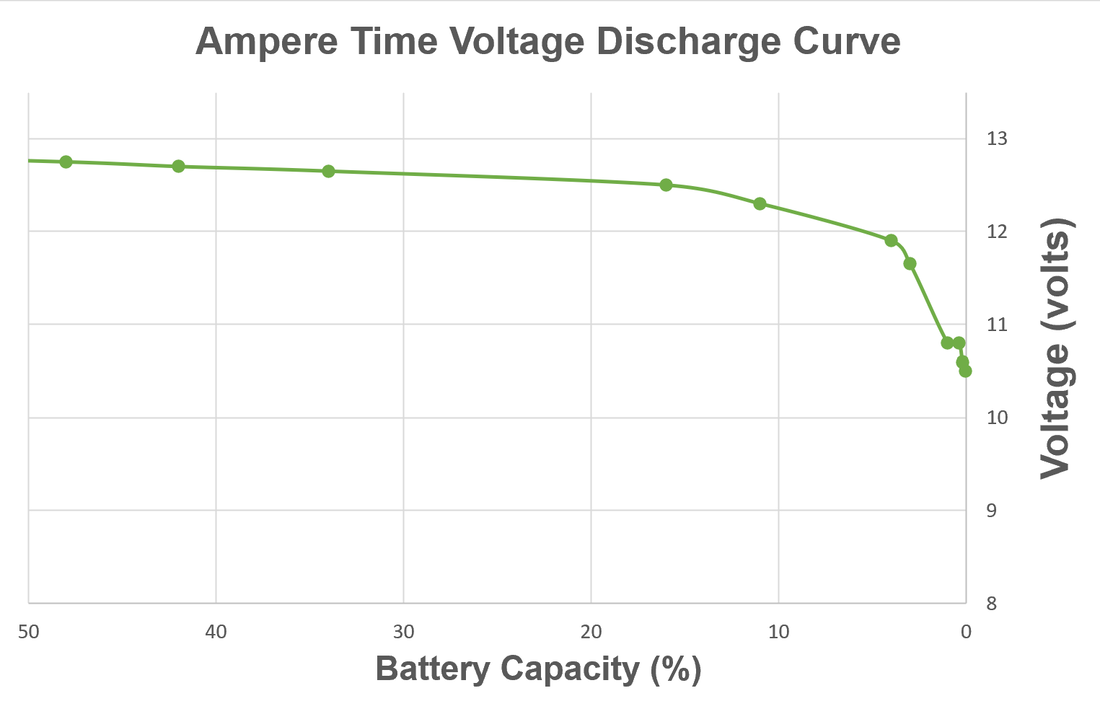 Ampere Time's 100Ah battery maintains 12V or more through 98.5Ah Ampere Time's 100Ah battery maintains 12V or more through 98.5Ah Capacity and Discharge Voltage Tests The first test of any battery that I review is a full discharge capacity test. Since these types of batteries are shipped with less than a full charge the battery must first be charged to full capacity. I used a 10A AC charger from Bioenno Power designed for lithium batteries to fully charge the battery. Next, I used a battery capacity tester from MakerHawk to measure the actual full discharge capacity of the battery to compare to its manufacturer's spec. I used a discharge current of 5A which is equivalent to ~65W since most typical astronomy setups will use less than this and the ones which use more will not be much more. Once fully discharged I repeated the process to check for consistency. The results were 102.8Ah for the first discharge and 103.1Ah for the second discharge. These are equivalent to 1307Wh and 1314Wh, respectively. So the results from both tests are consistent and show that the battery exceeds its specification of 100Ah by ~3%. Now, while the full capacity is important, the voltage drop off versus capacity is even more important since some equipment will not work properly if the voltage drops too much below 12V. So I captured the voltage versus capacity data during the discharge tests and this data is shown in the graph above. The average of both tests showed that the battery maintained its voltage above 12.0V for 98.5Ah or 1262Wh which is excellent compared to other batteries I tested or am aware of. By comparison the voltage of a typical lead acid battery drops below 12.0V at ~44% SOC. This means that you will get twice the capacity of a typical lead acid battery with this Ampere Time battery without risking damage to the battery. 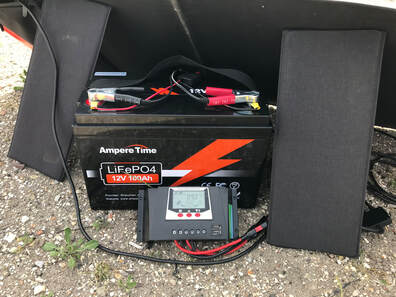 Solar Recharging in the field. Solar Recharging in the field. Re-Charge Tests There are multiple ways to recharge a battery and I tested the two most common. First, using the above mentioned 10A AC charger I was able to fully recharge a depleted battery in 10.5 hours. This matches very well the measured capacity of 103Ah and the fact that the charger is supplying 10A. Now there are higher capacity AC chargers like the 20A charger from Ampere Time or the much cheaper 20A charger from Expert Power which will charge the battery in half that time if desired. Out in the field we usually do not have access to AC power so we cannot use the AC charger to recharge the battery. In that case, the battery can easily be recharged with one or more solar panels and a solar charge controller. I used a pair of 100W solar panels from Jackery connected to the battery through a 20A solar charge controller from Bioenno Power. It is important to make sure that the solar charge controller is programed for a Li battery with the correct charge profile and voltages. With this setup, I was able to fully recharge the fully discharged battery in less than 11 hours on a sunny day. The two 100W panels supplied 11A during the bulk of that time while the sun was high in the sky. The charging current obviously falls off quickly as the sun gets lower in the sky. Now, one will not always have 11 hours of sunlight available but the battery reached 84% of full charge in just 8 hours. Also, It is likely not necessary to fully recharge a 100Ah battery during the day since typical astronomy power draws are 60W or less which would only use half the battery capacity over a 10 hour long night. So using a strategy of topping off the battery during the day one could run indefinitely so long as the days are sunny. Typical Astronomy Use Tests Before taking the battery out to a dark site I first set it up to power my astrophotography/EAA setup at my home observatory over a period of a month. My home setup includes a Celestron 11" Edge SCT, a Software Bisque MX mount, an ASI1600MC uncooled imaging camera, an ASI224MC guide camera, a Celestron Motorized focuser, a Pegasus Pocket PowerBox Advanced Power/USB Hub, a Beelink Mini-PC, a GL-iNET GL-AR750S-EXT wireless router and a Dell 15.4" laptop. Power was supplied directly to the Pegasus which then powered the MX and the Beelink. The cameras and focuser drew power from the MX while the router drew power from the Beelink. I connect from the laptop to the mini-pc through the wireless router from inside my house where I was able to power the laptop separately with house AC. Since the Ampere Time battery does not come with cables I needed to make my own to connect from the battery terminals to the Pegasus. I made a pair of 12 gauge cables with lug nuts on one end to connect to the battery and Anderson Power Pole connectors on the other end. Since the Pegasus uses the standard 5.5mm x 2.1mm connectors I made a cable with 5.5mm x 2.1mm connectors on one end to Anderson Power Pole connectors on the other end to connect the battery to the Pegasus. I prefer the Anderson Power Pole connectors wherever I can use them as they make a solid connection which is not easily dislodged in the dark. I prefer the genuine Anderson Power Poles compared the slightly less expensive imitations made in China. If you make your own you will need a crimping tool and the proper gauge wire for your current. This silicone wire will remain flexible in cold weather. If you do not want to make your own cables you can always buy one like this. Running in my home observatory I encountered no issues with the Ampere Time battery. All told, the load on the Ampere Time battery was ~30W so I was able to run many nights before I needed to recharge the battery. The final test was a field test at a dark site over multiple nights of astrophotography. For this setup I had all of the equipment mentioned above ( Celestron 11" Edge, ASI1600MC uncooled camera, Celestron motorized focuser, Pegasus Power Box Advanced, Beelink Mini-PC, GL-iNET GL-AR750S-EXT wireless router) but this time mounted on my travel mount, a Software Bisque MyT mount. Also, because I was using Hyperstar no guide camera was needed. But, because of significant dew I has to turn on the dew heater. In this configuration the power load was 52 watts over each of 3 nights. I did not recharge during the day and used a total of 60Ah (784Wh) in 15 hours over the 3 nights leaving me with 40Ah capacity remaining in the battery. That means that I could have run for another 10 hours for a total of 25 hours at my consumption rate before needing to recharge the battery. Now everyone has a different setup and a different power consumption. For instance, a cooled camera can add another 10 to 20W of power required depending upon the depth of cooling bringing the total power needed to 62W to 72W. That would still have allowed over 17 hours of run time before a recharge would be necessary. Also, if using a laptop directly connected to the setup instead of a mini-pc the power load could be as high as 100W. Even then, the Ampere Time 100Ah battery could supply all the power needed for a full 10 hours which would likely necessitate recharging during the day to enable multiple nights in the field. Regardless of your power requirements, the Ampere Time battery seems to be up to the challenge. Final Impressions
Overall I found that the Ampere Time 100Ah battery delivered the full capacity promised, is very light weight especially compared to a 100Ah lead acid battery and was straight forward to use and re-charge. Obviously I cannot comment on the long term reliability of this battery or any other manufacturer's battery through the simple tests I have available and testing only one battery. But I have no reason after having used it and checking out other reviews to expect it to be problematic. After my tests I even recommended this battery to my friend to replace the AGM batteries in his RV who purchased 3 of these and already installed them and tested them out when he joined me on my field tests. What I like about the Ampere Time 100Ah battery: 1. It is one of lowest cost LiFePO4 batteries on the market with an excellent reputation. 2. At 103Ah capacity it exceeded its 100Ah specification. 3. It comes with the best care, use and charging instructions of any battery I have tested. 4. They claim 24hr response from their technical support team. 5. It comes with a convenient carry strap. What I do not like: 1. No US based support hot line. Support is obtained either on line or by calling their number in Hong Kong. So, if you are looking for one of the least expensive of the LiFePO4 batteries on the market, you should seriously consider Ampere Time. I was not paid by Ampere Time for this review nor did they have any input to it but they did send the battery at my request and at no charge to me. Get 3% off an Ampere Time battery with Coupon Code CURTISM for a limited time when you purchase a battery and/or charger directly from Ampere Time's web site www.amperetime.com/?ref=VlYrkkdj Check out my video review of the Ampere Time battery on my YouTube Channel. Some links are Associate links from which I can earn commissions at not cost to you. If you would like to support my web site and its content please consider using my links when ordering products. |
Categories
All
Archives
January 2024
|
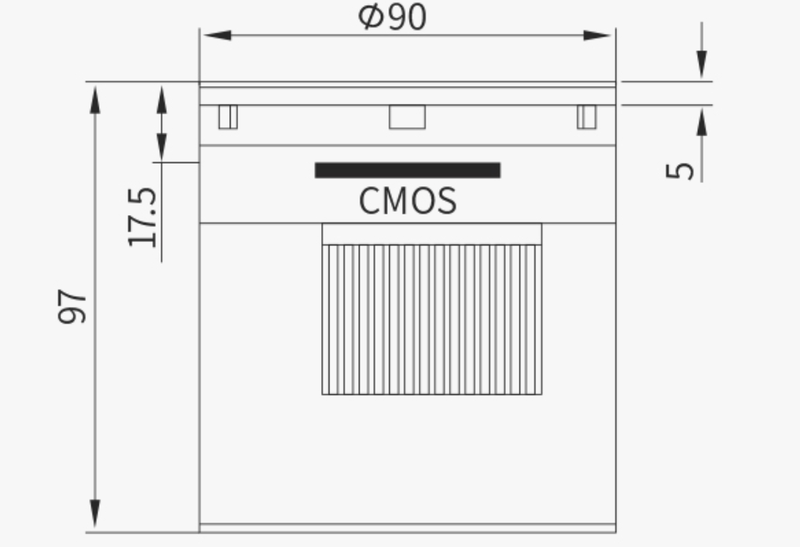
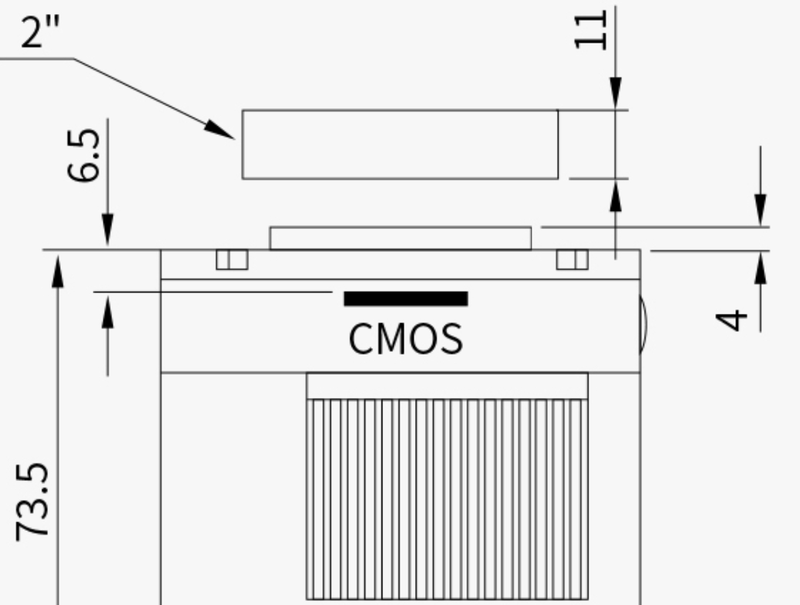
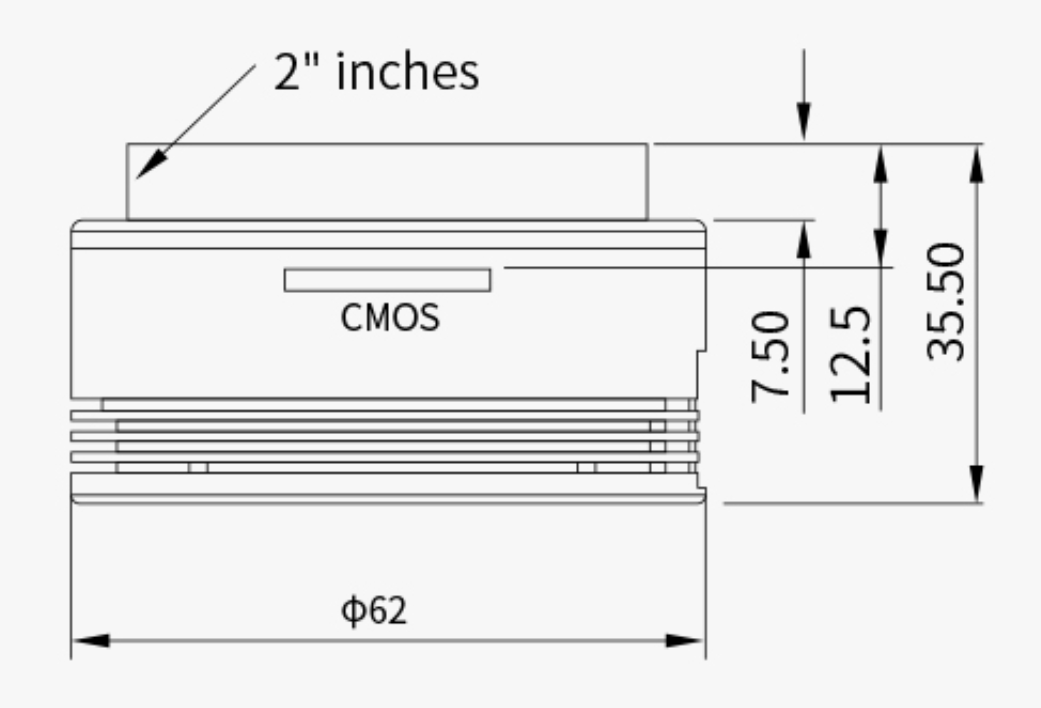
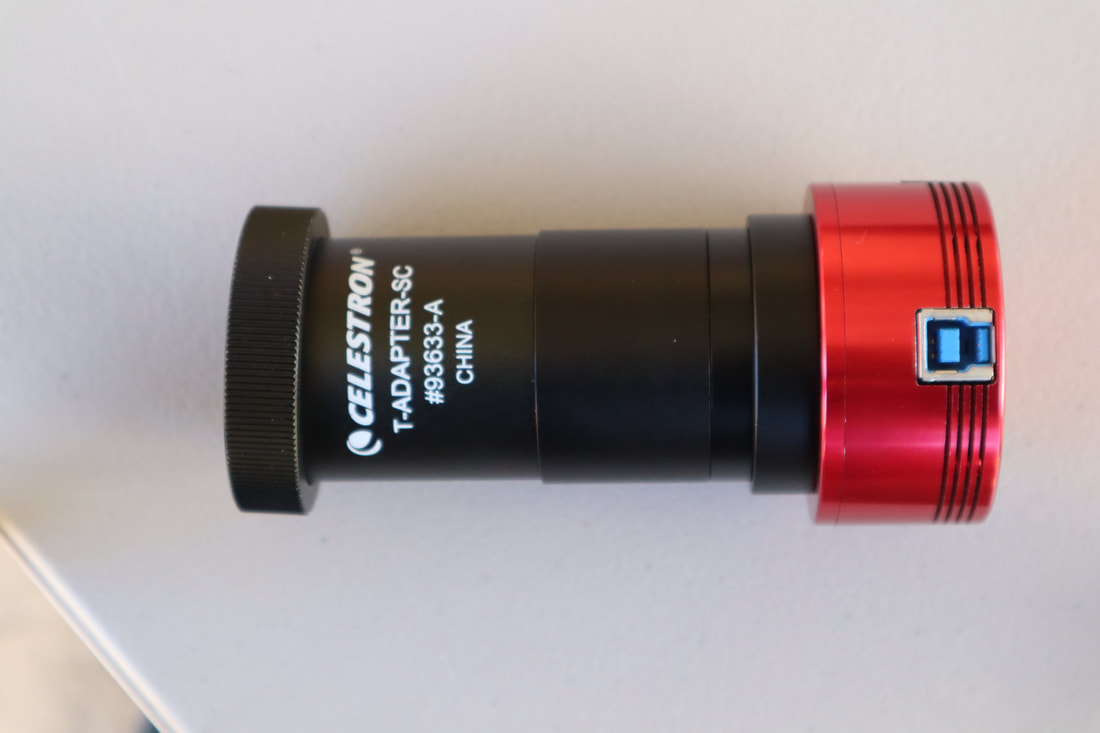
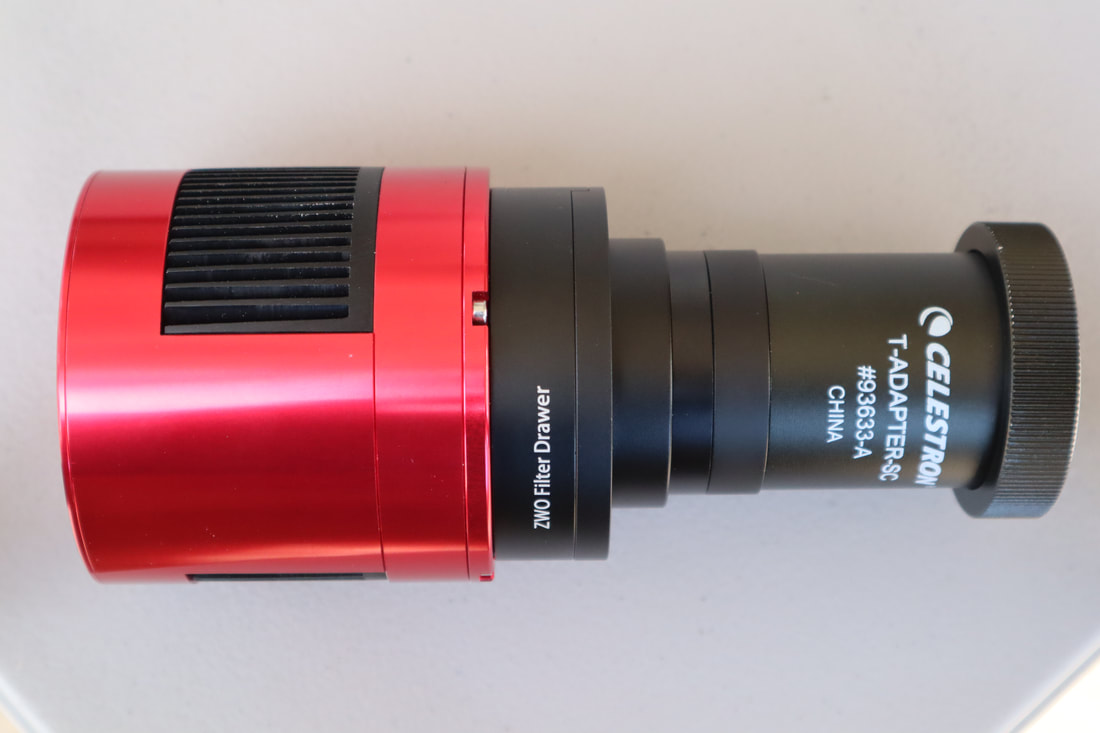
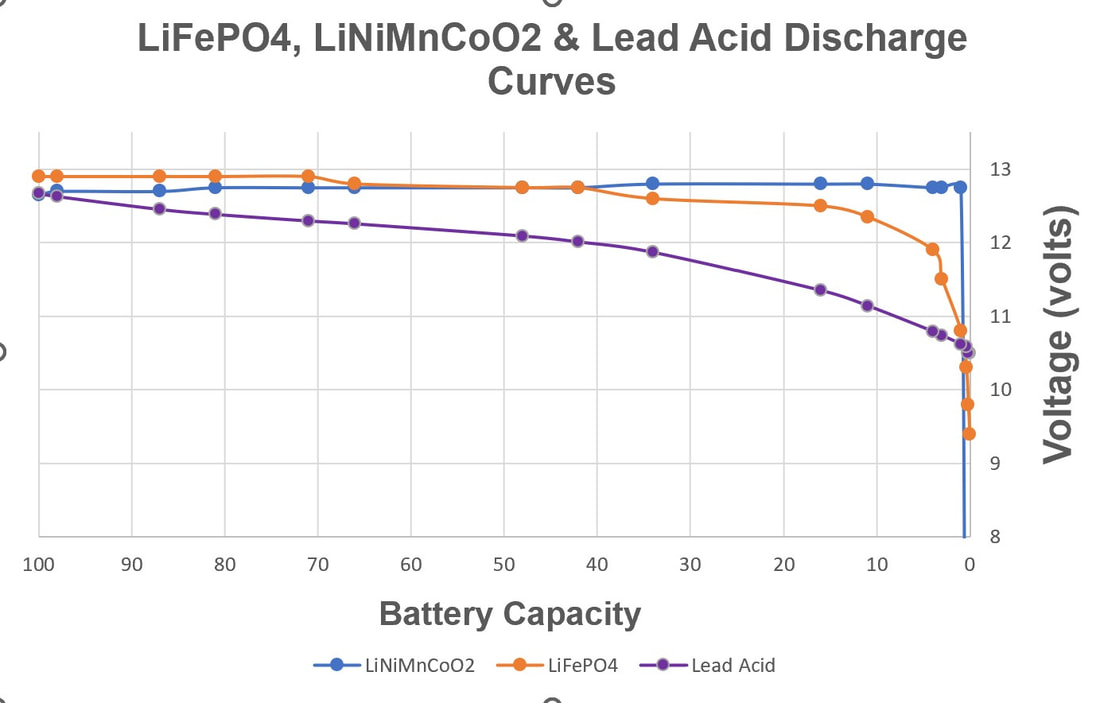
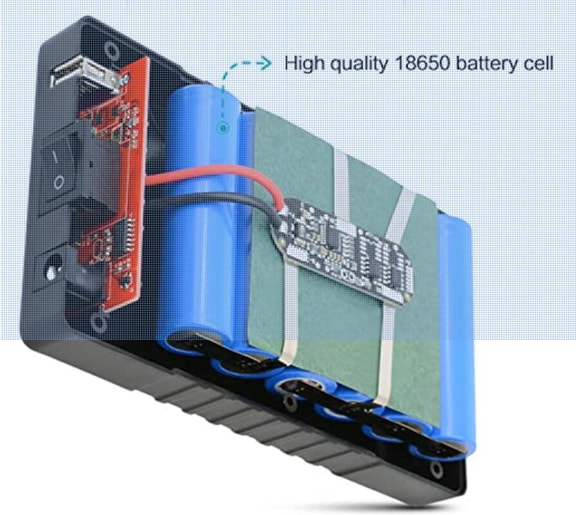
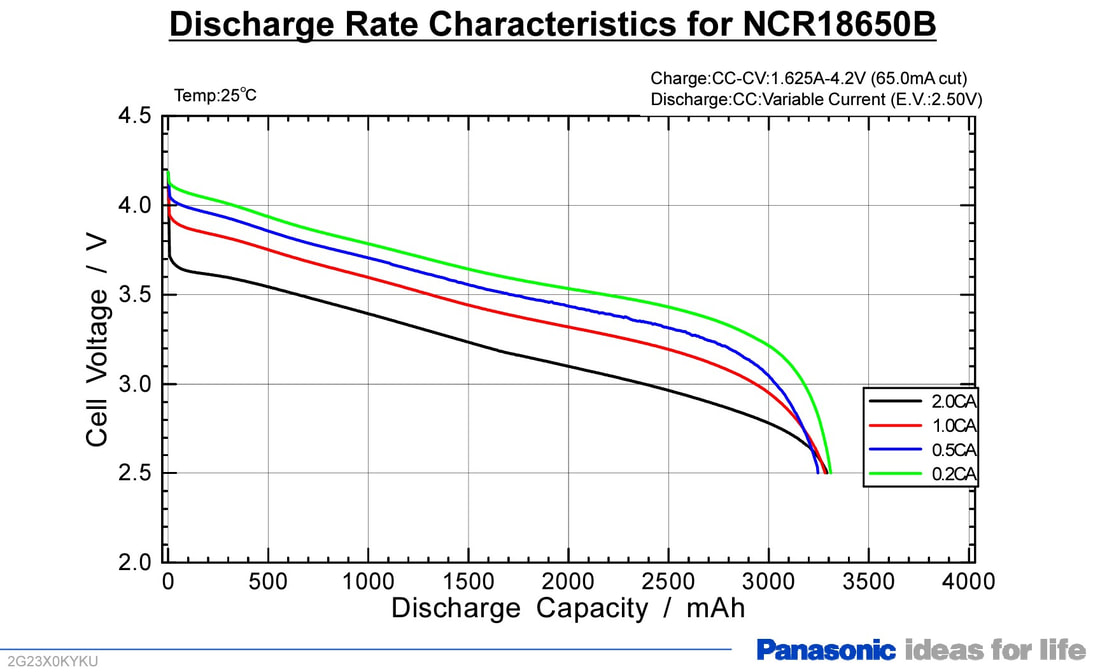
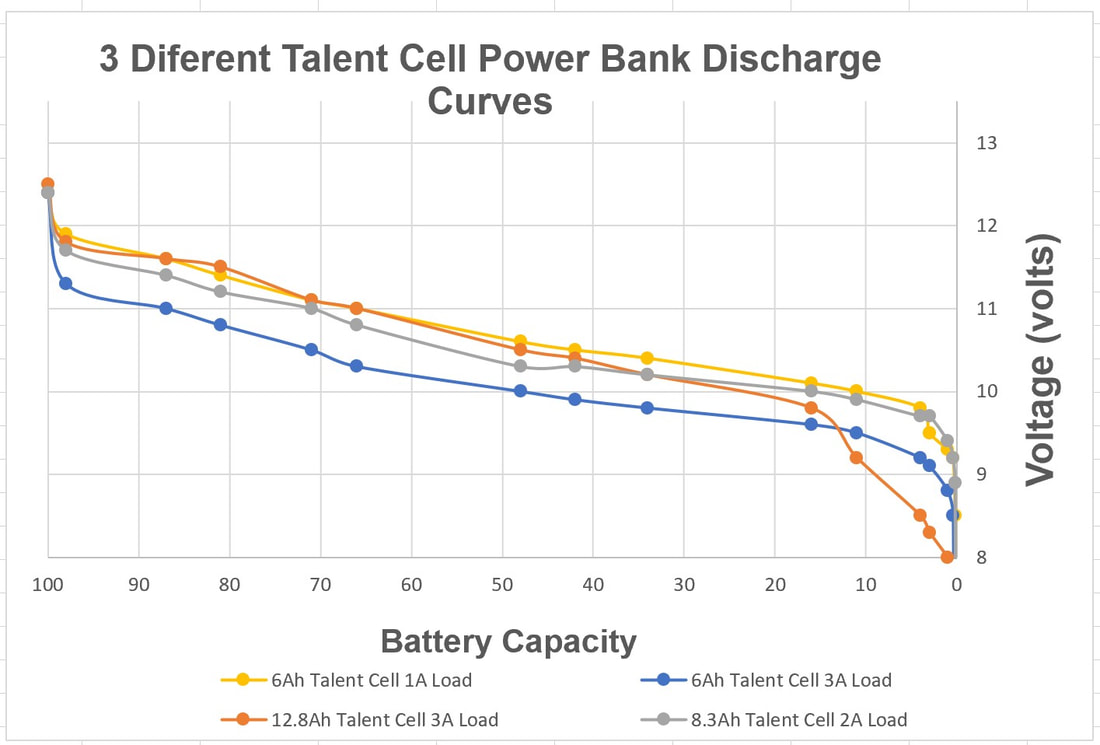
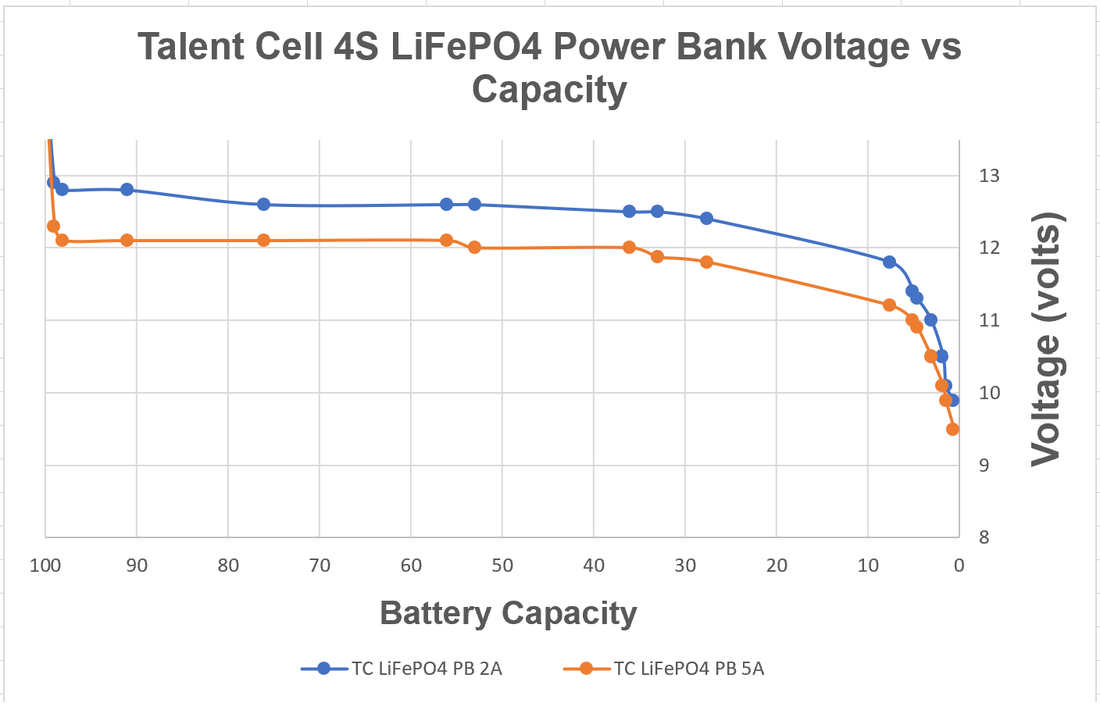
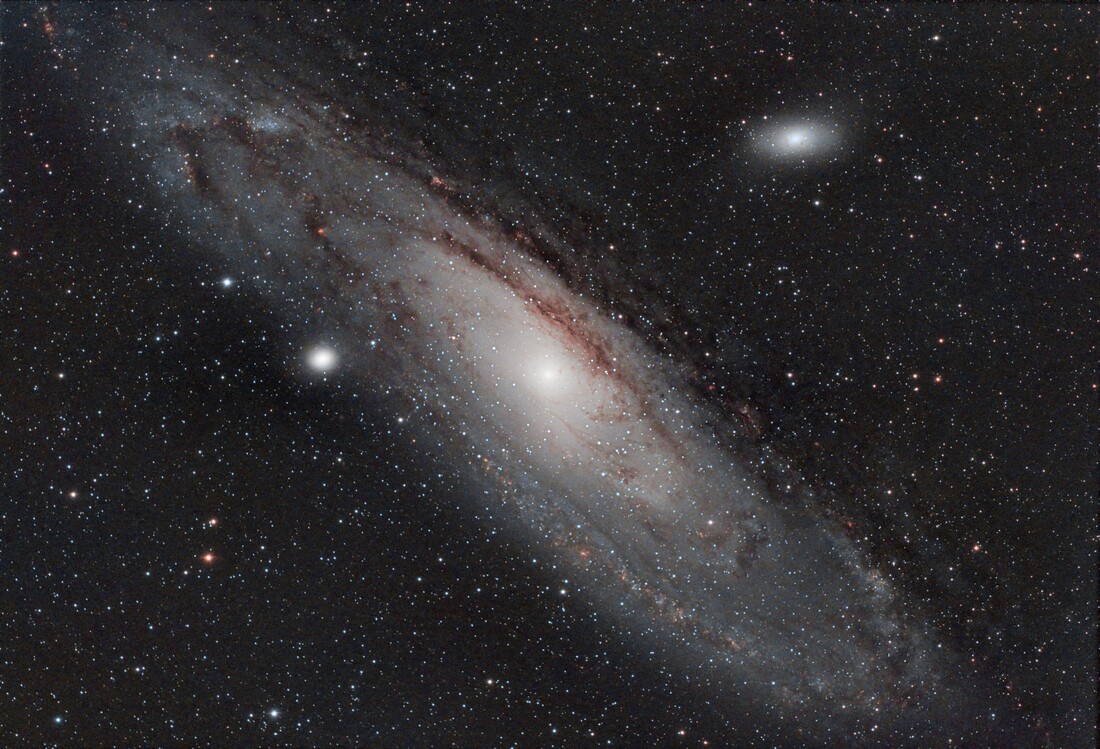
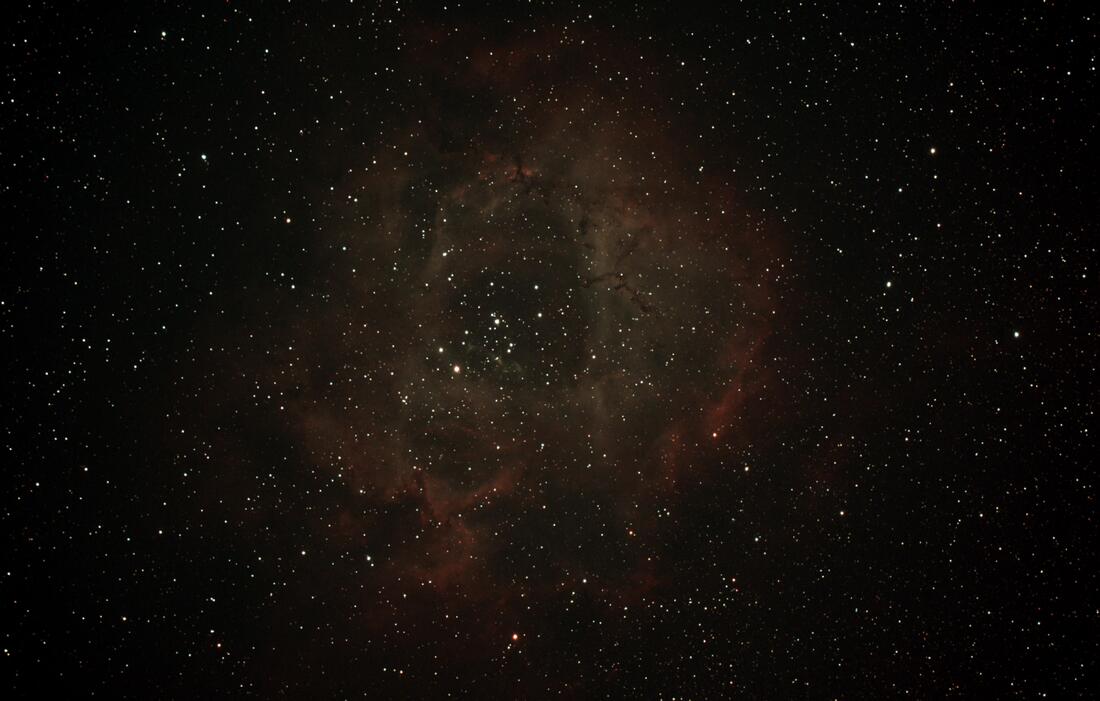
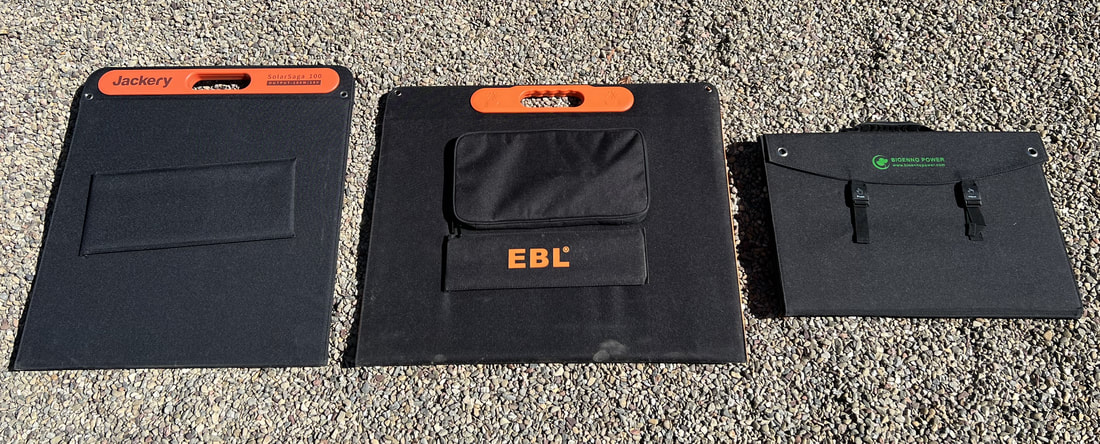
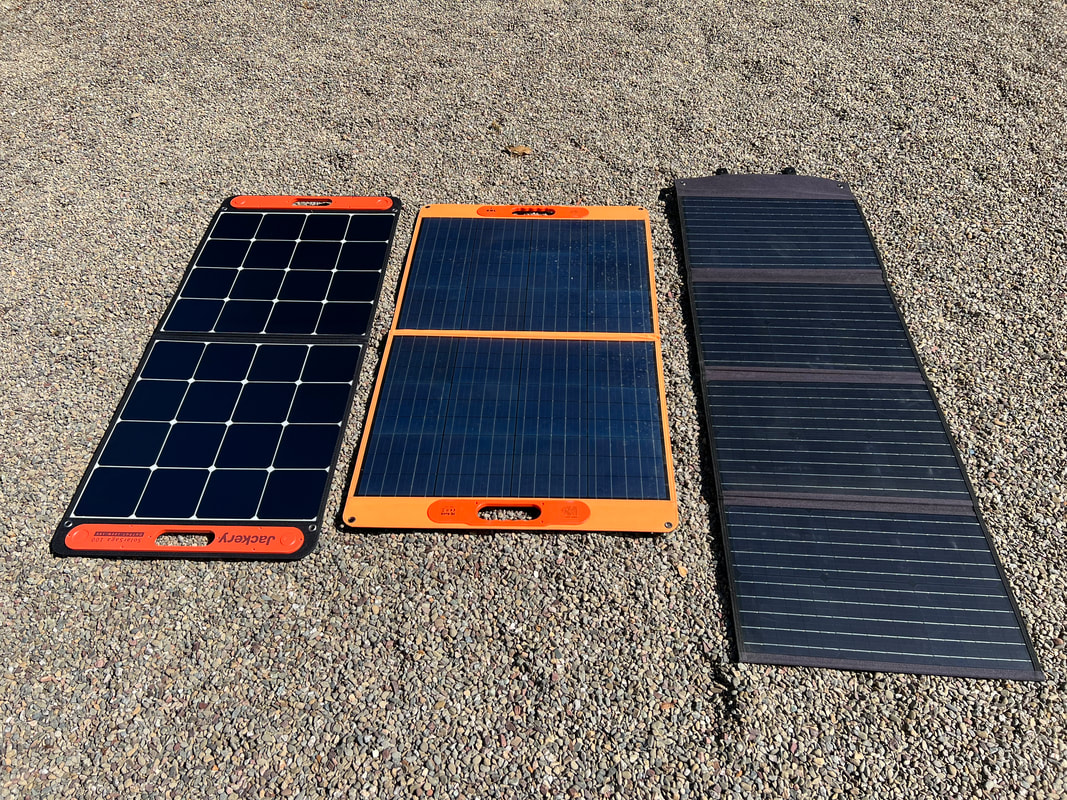
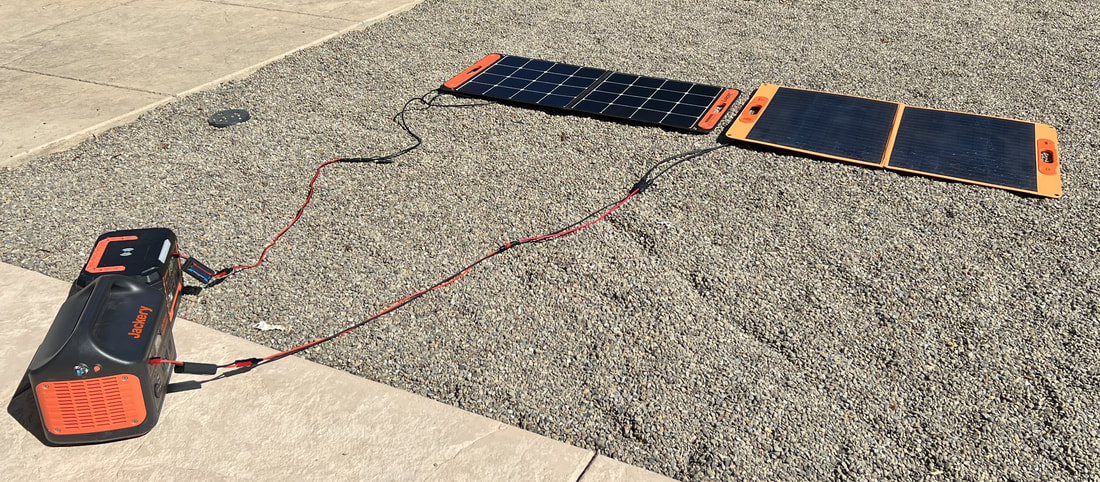
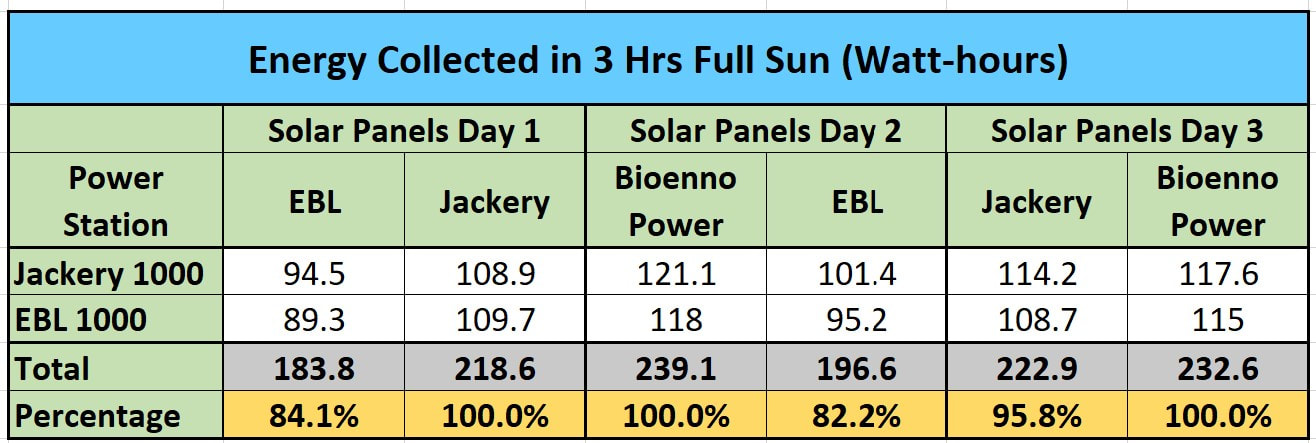
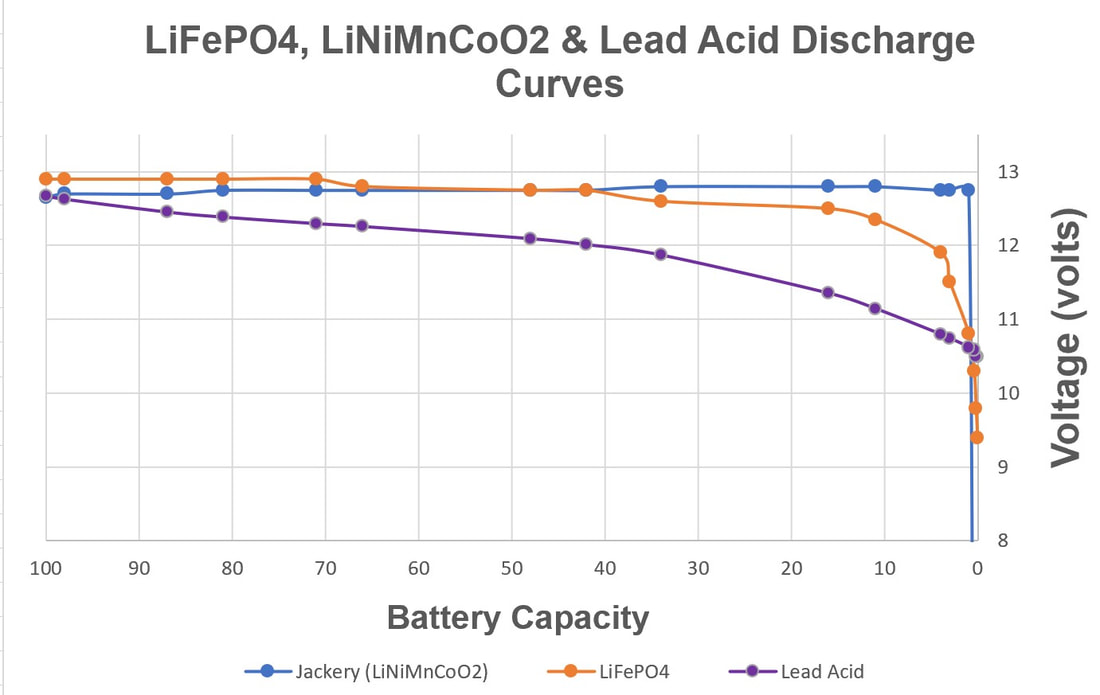
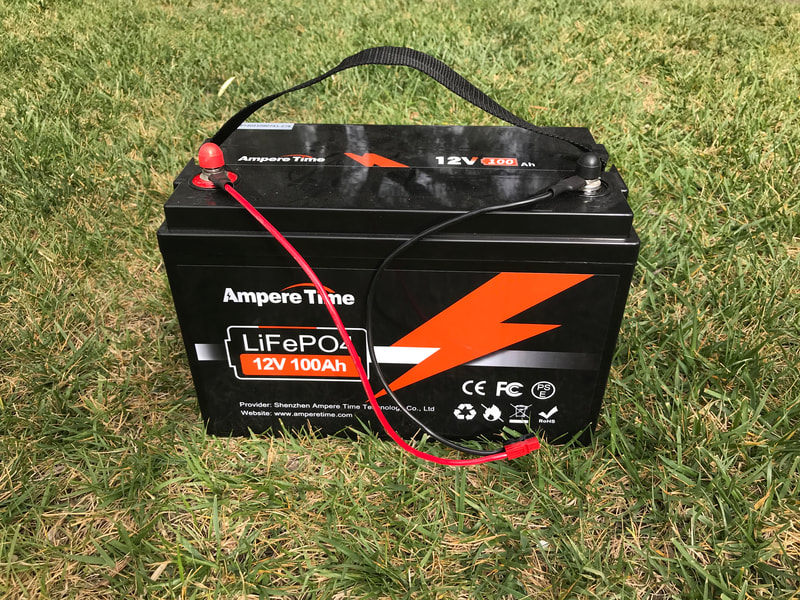
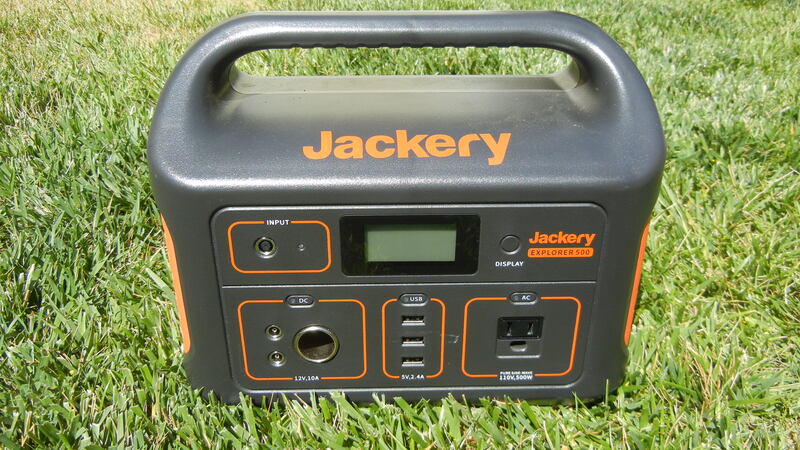
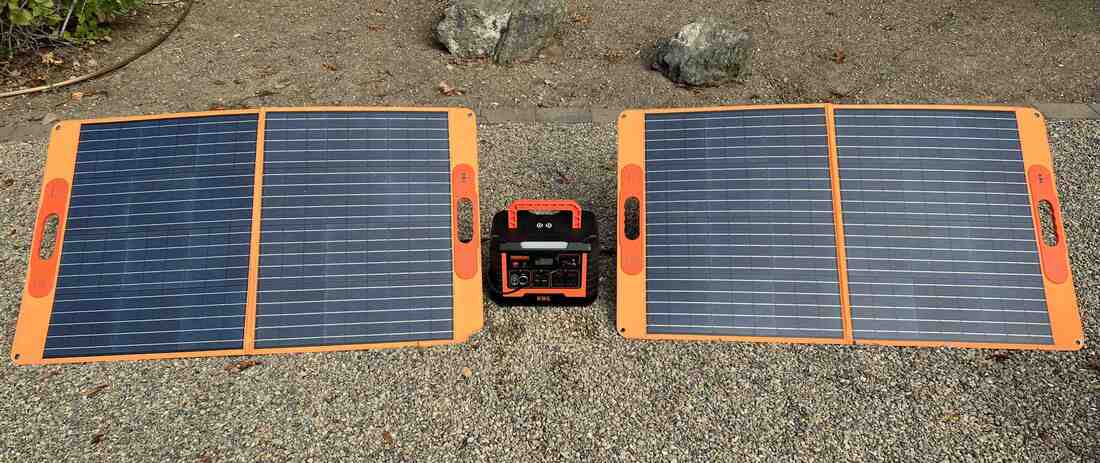
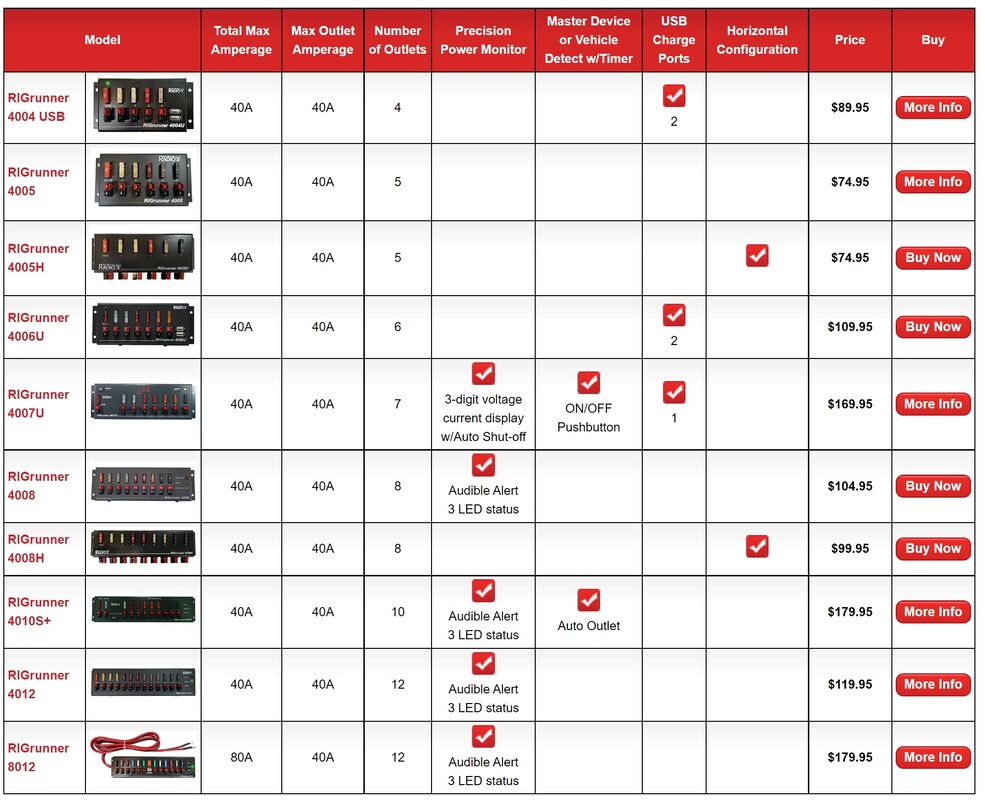
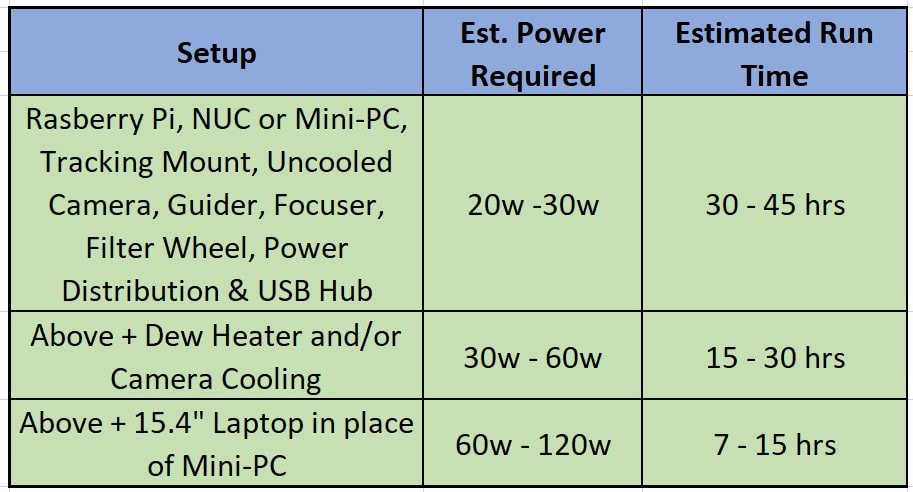
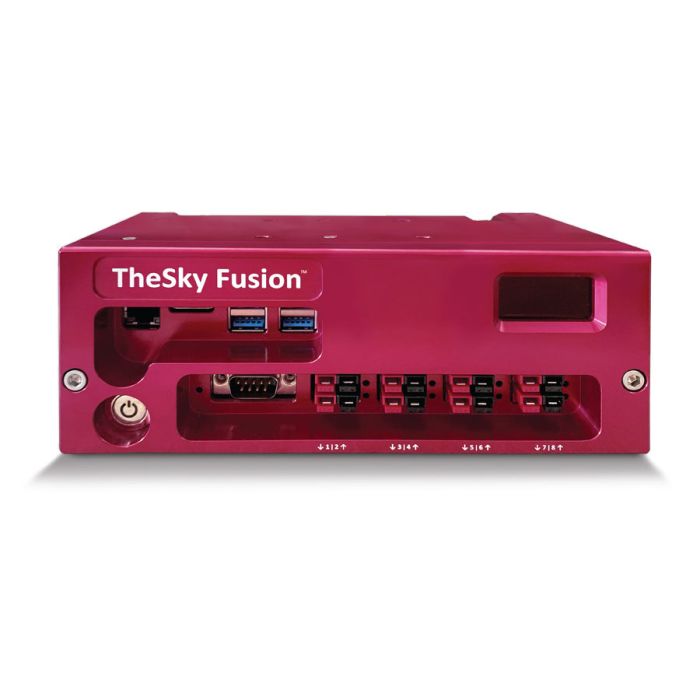
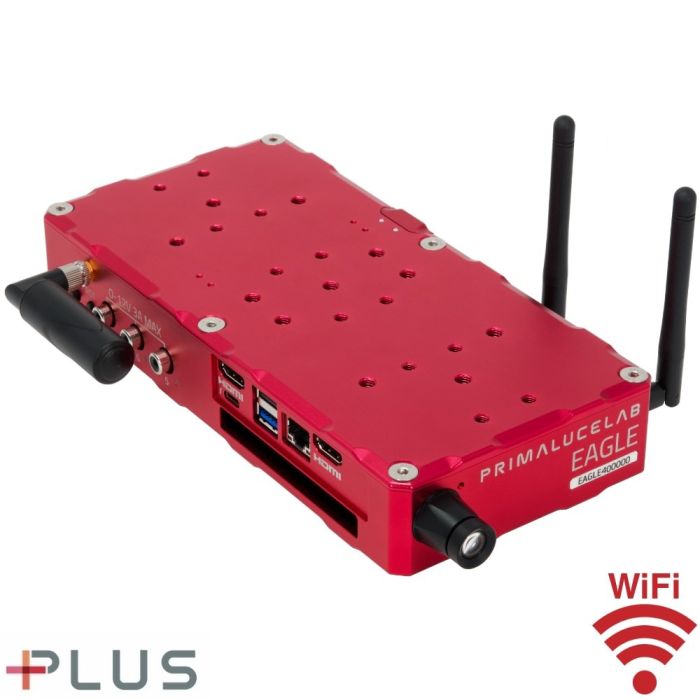
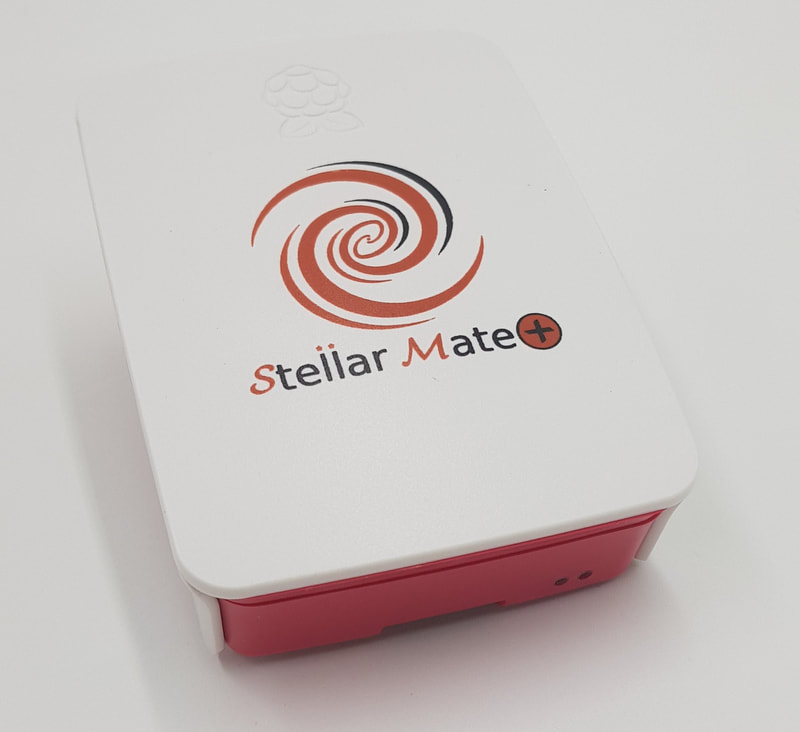
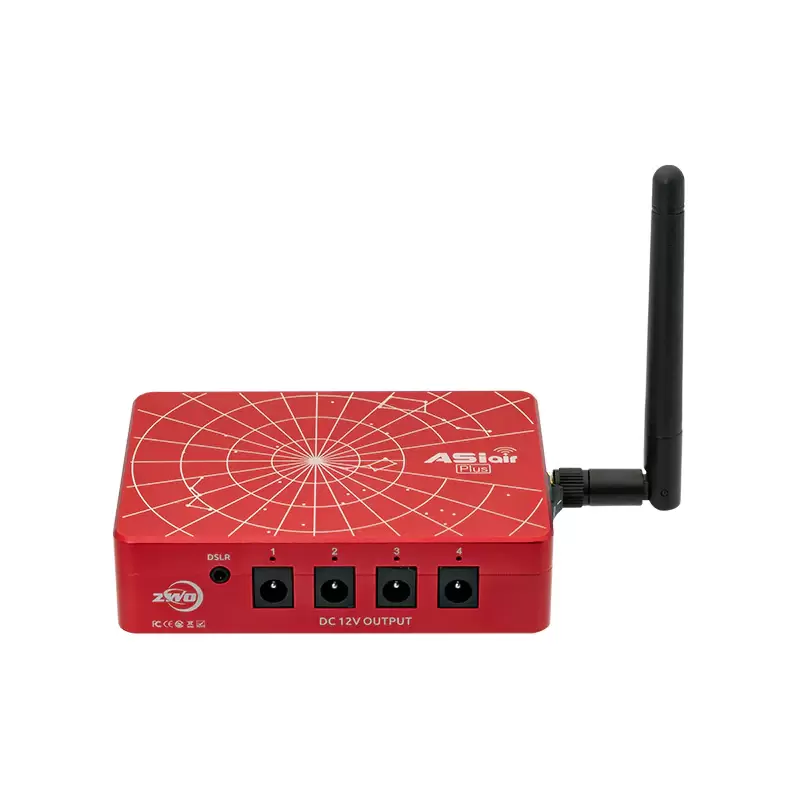
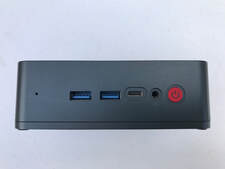
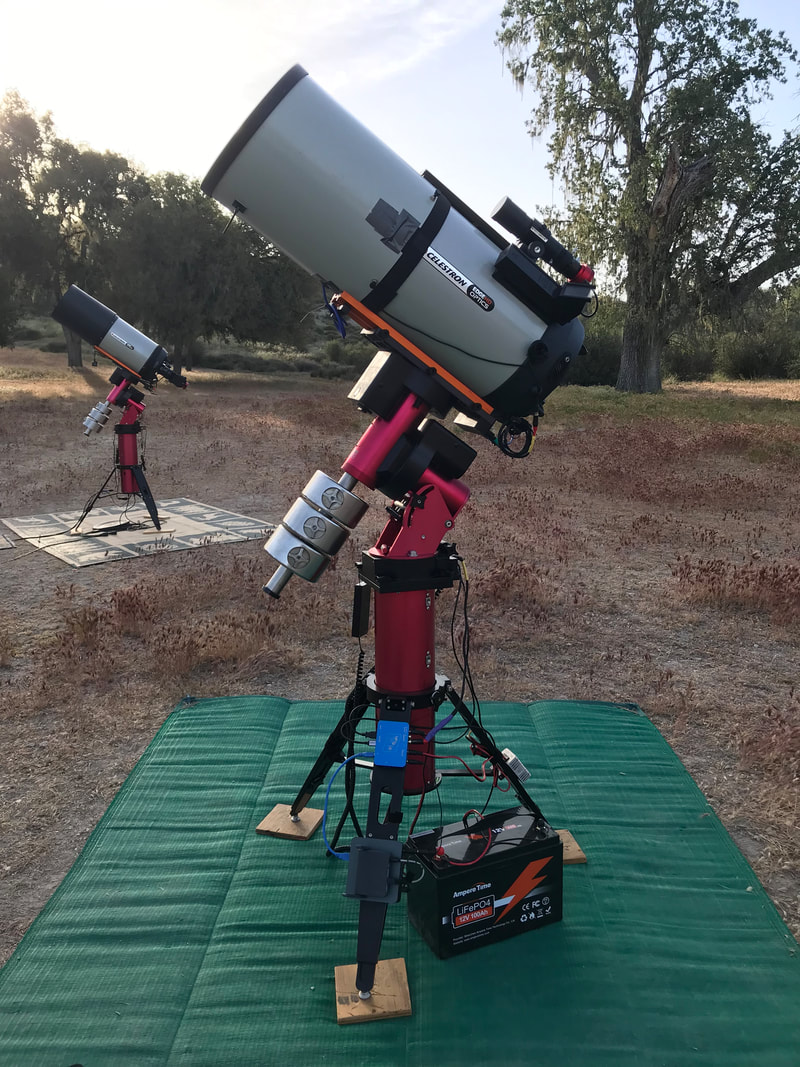
 RSS Feed
RSS Feed